Paul van Yperen's Blog, page 262
August 18, 2018
Irena Gawecka
Polish actress Irena Gawęcka (1901-1982) was a star of the silent cinema, who made 5 films between 1928 and 1930.
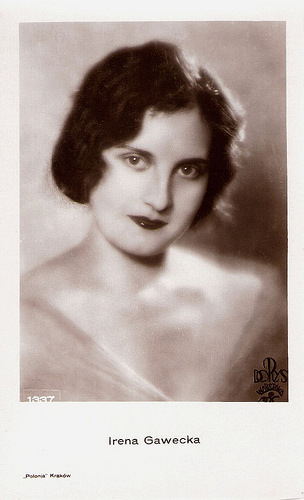
Polish postcard by Polonia, Kraków, no. 1337. Photo: Dorys, Warszawa.
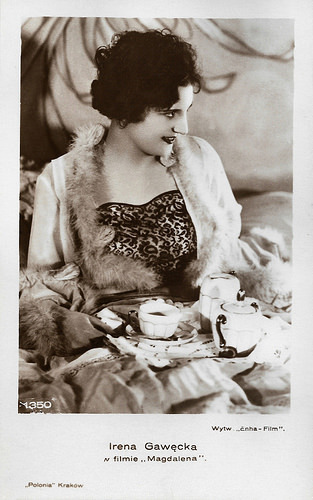
Polish postcard by Polonia, Kraków, no. 1350. Photo: Enhafilm. Publicity still for Magdalena (Konstanty Meglicki, 1929).
Cross of the Civil Service Ceremony
Irena Gawęcka was born in 1901 in Buk, Germany (now Poland).
As a young girl, she participated in the Greater Poland Uprising in the supply department, for which she was awarded the Cross of the Civil Service Ceremony by the Supreme People's Council in 1919.
Then, after high school, Irena Gawęcka travelled around Europe, nothing is known about her acting work during this period.
After returning to Poland, she made her film debut as Countess Zofia opposite Boleslaw Szczurkiewicz as her father in Szaleńcy/Madmen (1928), which was also the directorial debut of Leonard Buczkowski.
Gawęcka contributed with her role to the success of the film. In 1929, the film was awarded the Grand Prix and the Gold Medal at the Universal Exhibition in Paris.
In 1934, the film returned to the screens already in the sound version with music developed by Tadeusz Górzyński.
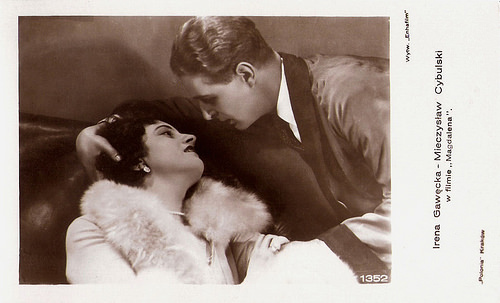
Polish postcard by Polonia, Kraków, no. 1352. Photo: Enhafilm. Publicity still for Magdalena (Konstanty Meglicki, 1929).
A promising acting career broken
In 1929, Irena Gawęcka appeared in three more Polish silent films.
The first was the drama Ponad snieg/Above the snow (Konstanty Meglicki, 1929) in which she had a supporting part.
The second was Magdalena (Konstanty Meglicki, 1929) and the third was the war drama Z dnia na dzien/One Day to the Day After Next (Joseph Lejtes, 1929), in which she played the leading role.
When the sound entered the Polish cinemas, Gawęcka retired. She only appeared in the small role of a fisher woman in the film Wiatr od morza/Wind from the Sea (Kazimierz Czynski, 1930), but it was not a success. Her promising acting career was broken.
After the war, Irena Gawęcka settled in France. There she died in 1982 in Le Chesnay at the age of 81.
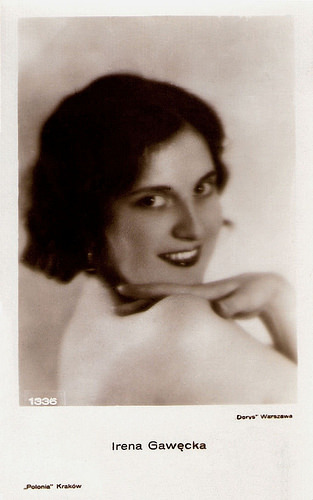
Polish postcard by Polonia, Kraków, no. 1335. Photo: Dorys, Warszawa.
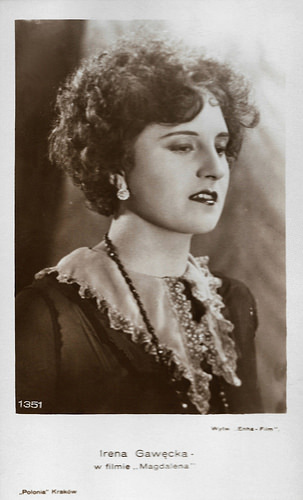
Polish postcard by Polonia, Kraków, no. 1351. Photo: Enhafilm. Publicity still for Magdalena (Konstanty Meglicki, 1929).
Sources: Filmpolski.pl (Polish), Wikipedia (Polish) and .

Polish postcard by Polonia, Kraków, no. 1337. Photo: Dorys, Warszawa.

Polish postcard by Polonia, Kraków, no. 1350. Photo: Enhafilm. Publicity still for Magdalena (Konstanty Meglicki, 1929).
Cross of the Civil Service Ceremony
Irena Gawęcka was born in 1901 in Buk, Germany (now Poland).
As a young girl, she participated in the Greater Poland Uprising in the supply department, for which she was awarded the Cross of the Civil Service Ceremony by the Supreme People's Council in 1919.
Then, after high school, Irena Gawęcka travelled around Europe, nothing is known about her acting work during this period.
After returning to Poland, she made her film debut as Countess Zofia opposite Boleslaw Szczurkiewicz as her father in Szaleńcy/Madmen (1928), which was also the directorial debut of Leonard Buczkowski.
Gawęcka contributed with her role to the success of the film. In 1929, the film was awarded the Grand Prix and the Gold Medal at the Universal Exhibition in Paris.
In 1934, the film returned to the screens already in the sound version with music developed by Tadeusz Górzyński.

Polish postcard by Polonia, Kraków, no. 1352. Photo: Enhafilm. Publicity still for Magdalena (Konstanty Meglicki, 1929).
A promising acting career broken
In 1929, Irena Gawęcka appeared in three more Polish silent films.
The first was the drama Ponad snieg/Above the snow (Konstanty Meglicki, 1929) in which she had a supporting part.
The second was Magdalena (Konstanty Meglicki, 1929) and the third was the war drama Z dnia na dzien/One Day to the Day After Next (Joseph Lejtes, 1929), in which she played the leading role.
When the sound entered the Polish cinemas, Gawęcka retired. She only appeared in the small role of a fisher woman in the film Wiatr od morza/Wind from the Sea (Kazimierz Czynski, 1930), but it was not a success. Her promising acting career was broken.
After the war, Irena Gawęcka settled in France. There she died in 1982 in Le Chesnay at the age of 81.

Polish postcard by Polonia, Kraków, no. 1335. Photo: Dorys, Warszawa.

Polish postcard by Polonia, Kraków, no. 1351. Photo: Enhafilm. Publicity still for Magdalena (Konstanty Meglicki, 1929).
Sources: Filmpolski.pl (Polish), Wikipedia (Polish) and .
Published on August 18, 2018 22:00
August 17, 2018
Photo by Félix
In the early 1910s, Edition Pathé Frères published many postcards of the studio's stars. Among them were Stacia Napierkowska, Robinne and Berthe Bovy. And the biggest star of them all was the marvellous comedian Max Linder. Their photos were often taken by photographer Félix, who worked in his studio in Paris.
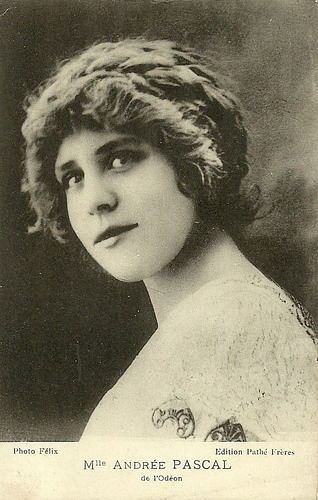
French postcard by Edition Pathé Frères. Photo: Félix.
Andrée Pascal (1892-1982) was a French actress who was highly active in French silent cinema. She did over 30 films for Pathé in the early 1910s, but suddenly stopped her film career after acting in L'empereur des pauvres (1922).
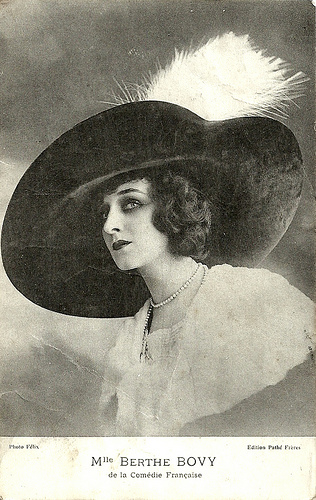
French postcard by Edition Pathé Frères. Photo: Félix. Caption: Mlle Berthe Bovy of the Comédie Française. 1910s.
Berthe Bovy (1887-1977) was a Belgian stage and screen actress. She was a regular stage actress at the Comédie Française since 1907, but also acted in some 30 early silent films at mainly Pathé, and afterwards in some 20 sound films between the 1930s and early 1970s. She also worked for TV.
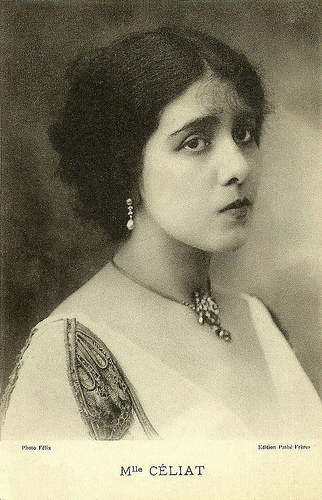
French postcard by Edition Pathé Frères. Photo: Félix.
Madeleine Céliat was a French stage actress who started out in film in 1909. She played in historical films by Pathé like Messalina (Henri Andréani 1910) and in one film by Eclair: La fin de Don Juan (Victorine-Hippolyte Jasset 1912), in which she played donna Anna. In 1912 Charles Pathé sent her to its Italian subsidiary Film d'Arte Italiana, in order to replace Francesca Bertini
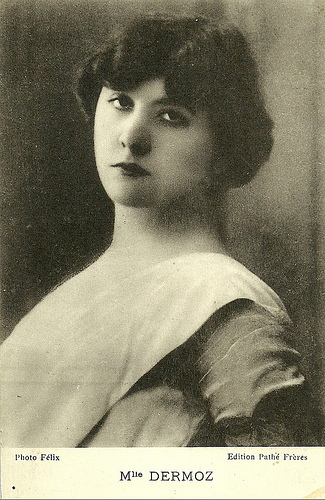
French postcard by Edition Pathé Frères. Photo: Félix.
Germaine Dermoz (1888–1966), younger sister of actress Jeanne Delvair, was a French film and theatre actress of the early-to-mid twentieth century. She is most famous for her portrayal of Madame Beudet in Germaine Dulac's avant-garde film La souriante Madame Beudet/The Smiling Madame Beudet (1923).
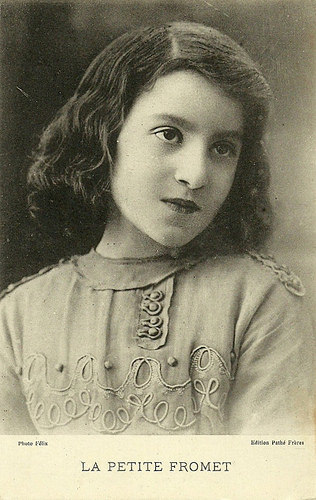
French postcard by Edition Pathé Frères. Photo: Félix.
Maria Fromet (1902-1967), aka 'la petite Fromet', is mostly known for her countless parts as little girl in the films by Pathé Frères of the early 1910s.
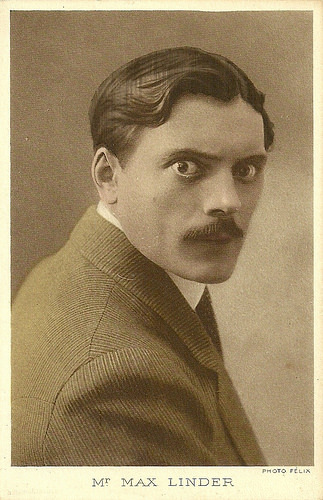
French postcard by Edition Pathé Frères. Photo: Félix.
French comedian Max Linder (1883-1925), with his trademark silk hat, stick and moustache was an influential pioneer of the silent film. He was largely responsible for the creation of the classic style of silent slapstick comedy and he was the highest paid entertainer of his day.
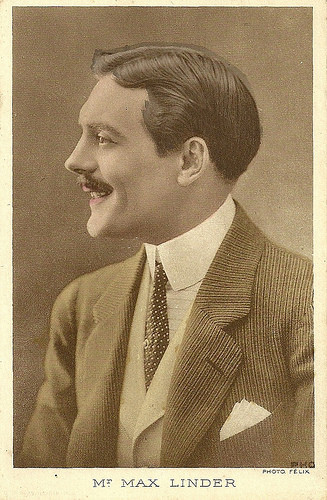
French postcard by Editions Pathé Frères. Photo: Félix.
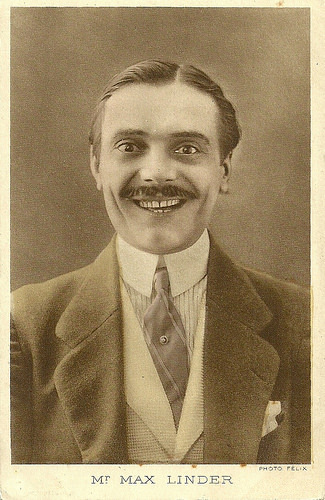
French postcard by Editions Pathé Frères. Photo: Félix.
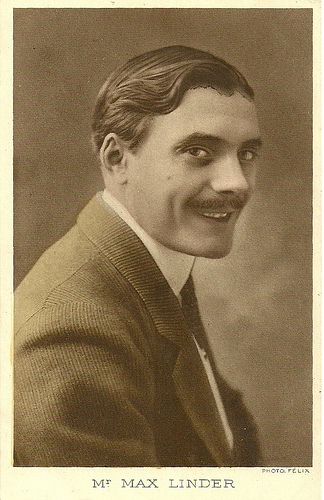
French postcard by Edition Pathé Frères. Photo: Félix.
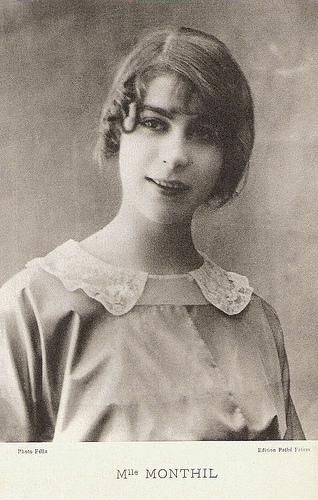
French postcard by Edition Pathé Frères. Photo: Félix.
Marcelle Monthil (1892-1950) was a French actress who started her film career in the days of the early silent cinema. She played dozens of supporting and bit parts during the 1930s and 1940s.
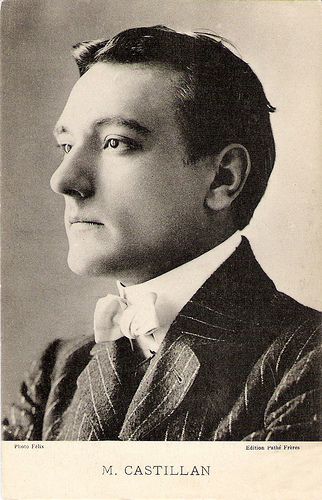
French postcard by Pathé Frères. Photo: Félix.
During the early 1910s handsome French actor Castillan starred in several short films by Pathé Frères.
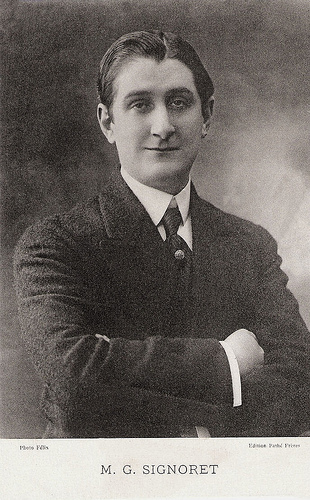
French postcard by Editions Pathé Frères. Photo: Félix.
Gabriel Signoret aka Signoret (1878-1937) was a French actor and director who played in some 85 films, mostly silent ones.
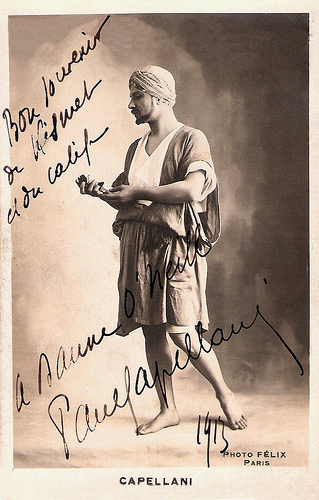
French postcard. Photo: Félix, Paris. Signed in 1913.
With his brooding good looks, stage and film actor Paul Capellani (1877-1960) became a successful star of some 100 French and American films between 1908 and 1930. He was the younger brother of noted film director Albert Capellani and he appeared in many of his brother’s silent historical films.

French postcard by Edition Pathé Frères. Photo: Félix.
Andrée Pascal (1892-1982) was a French actress who was highly active in French silent cinema. She did over 30 films for Pathé in the early 1910s, but suddenly stopped her film career after acting in L'empereur des pauvres (1922).

French postcard by Edition Pathé Frères. Photo: Félix. Caption: Mlle Berthe Bovy of the Comédie Française. 1910s.
Berthe Bovy (1887-1977) was a Belgian stage and screen actress. She was a regular stage actress at the Comédie Française since 1907, but also acted in some 30 early silent films at mainly Pathé, and afterwards in some 20 sound films between the 1930s and early 1970s. She also worked for TV.

French postcard by Edition Pathé Frères. Photo: Félix.
Madeleine Céliat was a French stage actress who started out in film in 1909. She played in historical films by Pathé like Messalina (Henri Andréani 1910) and in one film by Eclair: La fin de Don Juan (Victorine-Hippolyte Jasset 1912), in which she played donna Anna. In 1912 Charles Pathé sent her to its Italian subsidiary Film d'Arte Italiana, in order to replace Francesca Bertini

French postcard by Edition Pathé Frères. Photo: Félix.
Germaine Dermoz (1888–1966), younger sister of actress Jeanne Delvair, was a French film and theatre actress of the early-to-mid twentieth century. She is most famous for her portrayal of Madame Beudet in Germaine Dulac's avant-garde film La souriante Madame Beudet/The Smiling Madame Beudet (1923).

French postcard by Edition Pathé Frères. Photo: Félix.
Maria Fromet (1902-1967), aka 'la petite Fromet', is mostly known for her countless parts as little girl in the films by Pathé Frères of the early 1910s.

French postcard by Edition Pathé Frères. Photo: Félix.
French comedian Max Linder (1883-1925), with his trademark silk hat, stick and moustache was an influential pioneer of the silent film. He was largely responsible for the creation of the classic style of silent slapstick comedy and he was the highest paid entertainer of his day.

French postcard by Editions Pathé Frères. Photo: Félix.

French postcard by Editions Pathé Frères. Photo: Félix.

French postcard by Edition Pathé Frères. Photo: Félix.

French postcard by Edition Pathé Frères. Photo: Félix.
Marcelle Monthil (1892-1950) was a French actress who started her film career in the days of the early silent cinema. She played dozens of supporting and bit parts during the 1930s and 1940s.

French postcard by Pathé Frères. Photo: Félix.
During the early 1910s handsome French actor Castillan starred in several short films by Pathé Frères.

French postcard by Editions Pathé Frères. Photo: Félix.
Gabriel Signoret aka Signoret (1878-1937) was a French actor and director who played in some 85 films, mostly silent ones.

French postcard. Photo: Félix, Paris. Signed in 1913.
With his brooding good looks, stage and film actor Paul Capellani (1877-1960) became a successful star of some 100 French and American films between 1908 and 1930. He was the younger brother of noted film director Albert Capellani and he appeared in many of his brother’s silent historical films.
Published on August 17, 2018 22:00
August 16, 2018
Na semi vetrakh (1962)
In the early 1960s, the East-German film distributor VEB Progress Film-Verleih published some series of big cards for East-European films. Earlier we did a post on
the French-Czechoslovakian co-production La liberté surveillée/Provisional Liberty (Henri Aisner, Vladimír Vlcek, 1958) with Marina Vlady and Robert Hossein. Na semi vetrakh/Four Winds of Heaven (Stanislav Rostotskiy, 1962) is a Russian drama about the homefront during the Second World. The beautiful Larisa Luzhina plays the lead role, a peasant girl waiting for her beloved to return from the front.

Big East-German card by Progress, no. 1. Publicity still for Na semi vetrakh/Four Winds of Heaven (Stanislav Rostotskiy, 1962) with Larisa Luzhina .

Big East-German card by Progress, no. 2. Publicity still for Na semi vetrakh/Four Winds of Heaven (Stanislav Rostotskiy, 1962).

Big East-German card by Progress, no. 3. Publicity still for Na semi vetrakh/Four Winds of Heaven (Stanislav Rostotskiy, 1962) with Larisa Luzhina and Vyacheslav Tikhonov.

Big East-German card by Progress, no. 4. Publicity still for Na semi vetrakh/Four Winds of Heaven (Stanislav Rostotskiy, 1962).
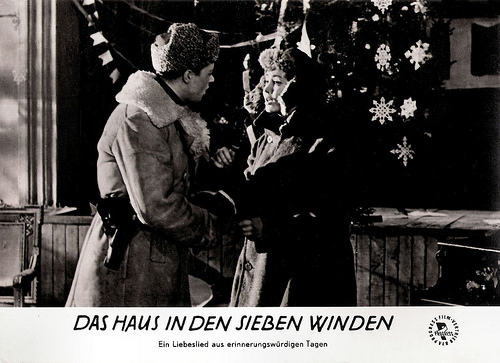
Big East-German card by Progress, no. 7. Publicity still for Na semi vetrakh/Four Winds of Heaven (Stanislav Rostotskiy, 1962).
Waiting in a back-water town
In the Russian war drama Na semi vetrakh (Stanislav Rostotskiy, 1962) a simple Russian girl, Svetlana Ivashova (Larisa Luzhina) arrives in a small, back-water town to meet her boyfriend Igor.
But the Second World War has begun and Igor has left to join the army. Svetlana decides to stay, to wait for his return and for the war to end.
Svetlana patiently waits in the post office, where her boyfriend works, for the war to end, and she does all she can to help defeat the Nazis. Sometimes she works on a newspaper.
When the post office is temporarily used as a hospital, she works as a nurse. Her hard work earns her a medal. Eventually Svetlana and her lover are happily reunited.
In the US Na semi vetrakh was titled Four Winds of Heaven and in the UK In Seven Winds.
Other actors in the cast were Vyacheslav Tikhonov as Captain Suzdalev, Klara Luchko as Doctor Natalia Guseva and Leonid Bykov as Postman.

Big East-German card by Progress, no. 8. Publicity still for Na semi vetrakh/Four Winds of Heaven (Stanislav Rostotskiy, 1962) with Larisa Luzhina .
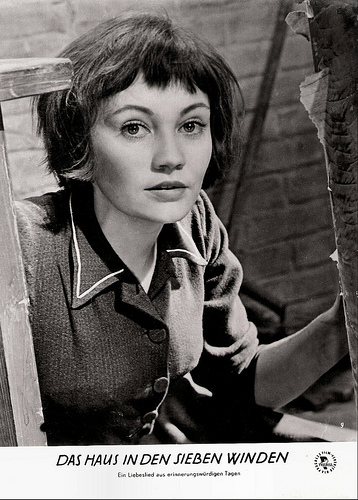
Big East-German card by Progress, no. 9. Publicity still for Na semi vetrakh/Four Winds of Heaven (Stanislav Rostotskiy, 1962) with Larisa Luzhina .
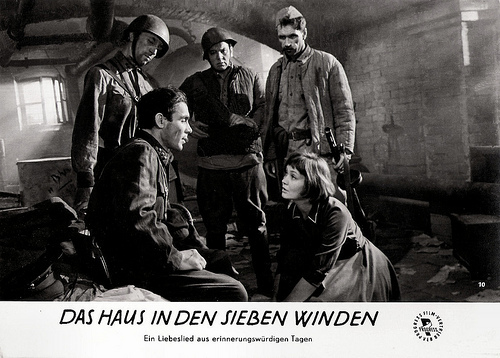
Big East-German card by Progress, no. 10. Publicity still for Na semi vetrakh/Four Winds of Heaven (Stanislav Rostotskiy, 1962) with Larisa Luzhina .
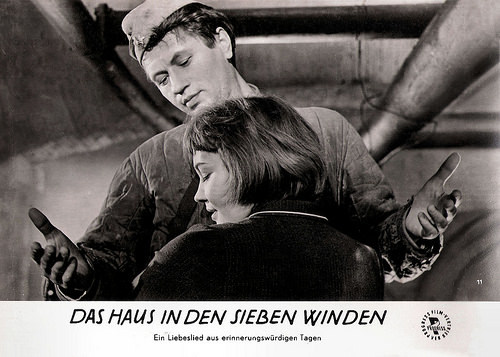
Big East-German card by Progress, no. 11. Publicity still for Na semi vetrakh/Four Winds of Heaven (Stanislav Rostotskiy, 1962) with Larisa Luzhina and Leonid Bykov.
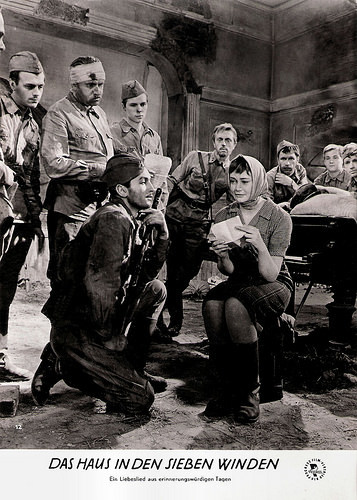
Big East-German card by Progress, no. 12. Publicity still for Na semi vetrakh/Four Winds of Heaven (Stanislav Rostotskiy, 1962) with Larisa Luzhina .
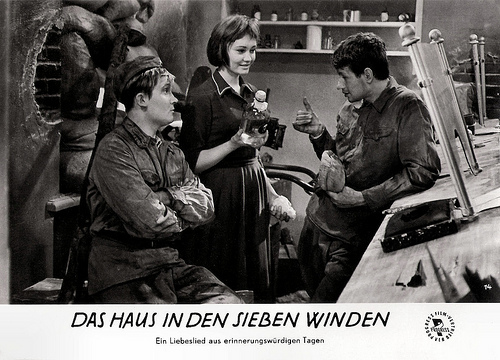
Big East-German card by Progress, no. 14. Publicity still for Na semi vetrakh/Four Winds of Heaven (Stanislav Rostotskiy, 1962) with Larisa Luzhina .
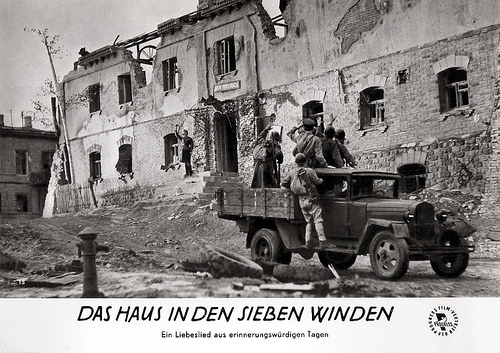
Big East-German card by Progress, no. 15. Publicity still for Na semi vetrakh/Four Winds of Heaven (Stanislav Rostotskiy, 1962).
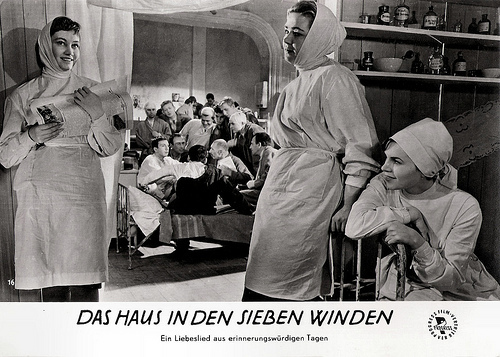
Big East-German card by Progress, no. 16. Publicity still for Na semi vetrakh/Four Winds of Heaven (Stanislav Rostotskiy, 1962) with Larisa Luzhina .
Source: Kinoglaz.fr and IMDb.
the French-Czechoslovakian co-production La liberté surveillée/Provisional Liberty (Henri Aisner, Vladimír Vlcek, 1958) with Marina Vlady and Robert Hossein. Na semi vetrakh/Four Winds of Heaven (Stanislav Rostotskiy, 1962) is a Russian drama about the homefront during the Second World. The beautiful Larisa Luzhina plays the lead role, a peasant girl waiting for her beloved to return from the front.

Big East-German card by Progress, no. 1. Publicity still for Na semi vetrakh/Four Winds of Heaven (Stanislav Rostotskiy, 1962) with Larisa Luzhina .

Big East-German card by Progress, no. 2. Publicity still for Na semi vetrakh/Four Winds of Heaven (Stanislav Rostotskiy, 1962).

Big East-German card by Progress, no. 3. Publicity still for Na semi vetrakh/Four Winds of Heaven (Stanislav Rostotskiy, 1962) with Larisa Luzhina and Vyacheslav Tikhonov.

Big East-German card by Progress, no. 4. Publicity still for Na semi vetrakh/Four Winds of Heaven (Stanislav Rostotskiy, 1962).

Big East-German card by Progress, no. 7. Publicity still for Na semi vetrakh/Four Winds of Heaven (Stanislav Rostotskiy, 1962).
Waiting in a back-water town
In the Russian war drama Na semi vetrakh (Stanislav Rostotskiy, 1962) a simple Russian girl, Svetlana Ivashova (Larisa Luzhina) arrives in a small, back-water town to meet her boyfriend Igor.
But the Second World War has begun and Igor has left to join the army. Svetlana decides to stay, to wait for his return and for the war to end.
Svetlana patiently waits in the post office, where her boyfriend works, for the war to end, and she does all she can to help defeat the Nazis. Sometimes she works on a newspaper.
When the post office is temporarily used as a hospital, she works as a nurse. Her hard work earns her a medal. Eventually Svetlana and her lover are happily reunited.
In the US Na semi vetrakh was titled Four Winds of Heaven and in the UK In Seven Winds.
Other actors in the cast were Vyacheslav Tikhonov as Captain Suzdalev, Klara Luchko as Doctor Natalia Guseva and Leonid Bykov as Postman.

Big East-German card by Progress, no. 8. Publicity still for Na semi vetrakh/Four Winds of Heaven (Stanislav Rostotskiy, 1962) with Larisa Luzhina .

Big East-German card by Progress, no. 9. Publicity still for Na semi vetrakh/Four Winds of Heaven (Stanislav Rostotskiy, 1962) with Larisa Luzhina .

Big East-German card by Progress, no. 10. Publicity still for Na semi vetrakh/Four Winds of Heaven (Stanislav Rostotskiy, 1962) with Larisa Luzhina .

Big East-German card by Progress, no. 11. Publicity still for Na semi vetrakh/Four Winds of Heaven (Stanislav Rostotskiy, 1962) with Larisa Luzhina and Leonid Bykov.

Big East-German card by Progress, no. 12. Publicity still for Na semi vetrakh/Four Winds of Heaven (Stanislav Rostotskiy, 1962) with Larisa Luzhina .

Big East-German card by Progress, no. 14. Publicity still for Na semi vetrakh/Four Winds of Heaven (Stanislav Rostotskiy, 1962) with Larisa Luzhina .

Big East-German card by Progress, no. 15. Publicity still for Na semi vetrakh/Four Winds of Heaven (Stanislav Rostotskiy, 1962).

Big East-German card by Progress, no. 16. Publicity still for Na semi vetrakh/Four Winds of Heaven (Stanislav Rostotskiy, 1962) with Larisa Luzhina .
Source: Kinoglaz.fr and IMDb.
Published on August 16, 2018 22:00
August 15, 2018
5 million pageviews for EFSP - Alain Delon
The pageview teller of European Film Star Postcards passed the 5,000,000, and today we repost the most popular page ever. The Alain Delon page, which we updated most recently on 3 July 2015 and counted 26,049 pageviews. B
ut what does it tell? For us, it was a good excuse to update the five most popular posts, and a way to thank you for visiting our blog.
And we are Paul van Yperen and partner-in-crime Ivo Blom. So, thanks!
A highlight at Il Cinema Ritrovato 2015 is the open-air screening tonight of Rocco e i suoi fratelli/Rocco and His Brothers (Luchino Visconti, 1960) in a magical black and white, thanks to a new restoration. Today's post is about Alain Delon (1935), the actor who played Rocco in this landmark Italian film. Delon was the breathtakingly good-looking James Dean of the European cinema of the late 1950s and early 1960s who proved in this film that he was also a magnificent actor.
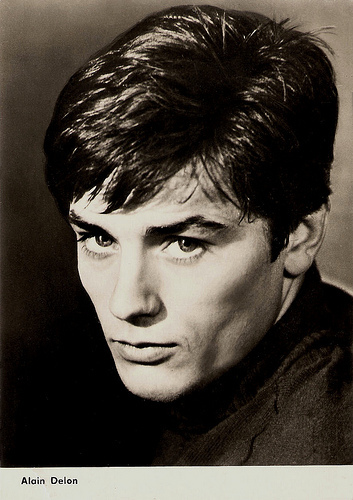
East-German postcard by VEB Progress Film-Vertrieb, Berlin, 1967. retail price: 0,20 MDN.Photo: publicity still for Rocco e i suoi fratelli/Rocco and his brothers (Luchino Visconti, 1960).

French postcard by E.D.U.G., no. 22. Photo: Sam Lévin.

German postcard by Krüger. Photo: Ufa.
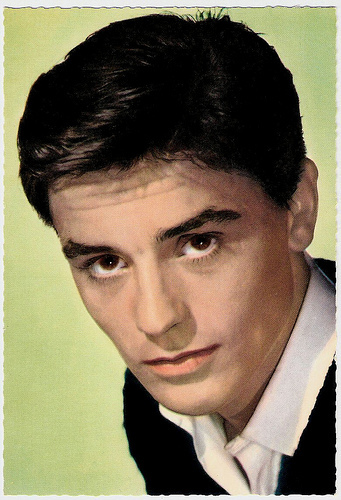
German postcard by ISV, no. H 25.
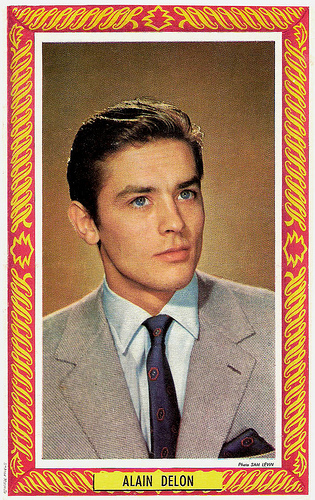
French postcard by St. Anne, Marseille. Photo: Sam Lévin.
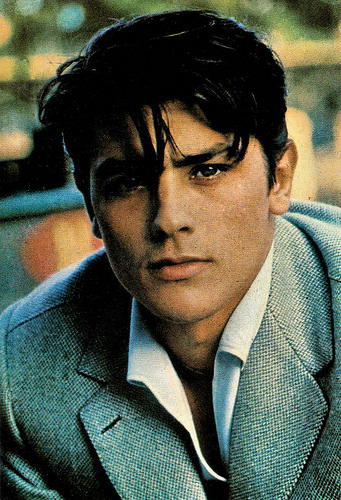
Spanish postcard, no. 161. Photo: Philippe R. Doumic.
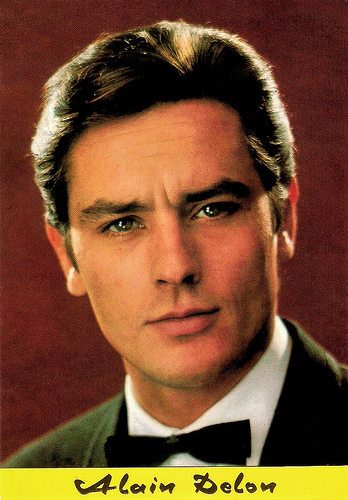
Spanish postcard by Bergas Ind. Graf., Barcelona, no. 463, 1967.
Stormy Childhood
Alain Fabien Maurice Marcel Delon was born in Sceaux, a suburb of Paris in 1935. His parents, Édith Arnold and Fabien Delon, divorced when Delon was four. He had a stormy childhood and was six times expelled from different schools.
At 14, Delon left school, and worked for a brief time at his stepfather Paul Boulogne's butcher shop. Three years later, the 17-year-old enlisted in the French Marines, serving in 1953-1954 in Indochina as a parachutist. In 1956, after being dishonourably discharged from the military, he returned to France. He had little money and worked at various odd jobs, including as a waiter, salesman, and porter in the Les Halles market.
During this time he became friends with the actress Brigitte Auber , and joined her on a trip to the Cannes Film Festival, where his film career would begin with a screentest for David O’Selznick. He didn't go to Hollywood, but decided to stay in France. He made his film debut in Quand la femmes s'en mele/Send a Woman When the Devil Fails (Yves Allégret, 1957).
In 1958, during the making of the love story Christine (Pierre Gaspard-Huit, 1959), Delon met Romy Schneider . They would be engaged till 1964.
Delon’s first outstanding success came with the role of the parasite Tom Ripley in the sundrenched thriller Plein soleil/Purple Noon (René Clément, 1960), based on the crime novel The Talented Mr. Ripley by Patricia Highsmith. Delon presented a psychological portrait of a murderous young cynic who attempts to take on the identity of his victim. The critics liked his performance. According to Wikipedia , Patricia Highsmith herself was also a fan of his portrayal.
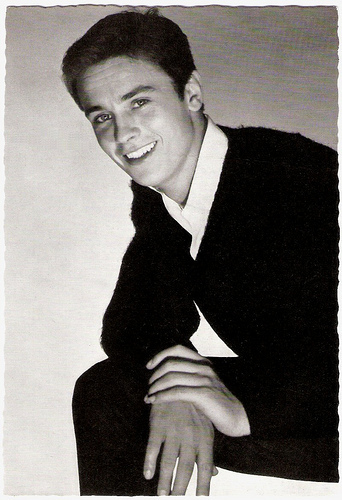
German postcard by WS-Druck, Wanne Eickel, no. 419. Photo: Sam Lévin, 1957.
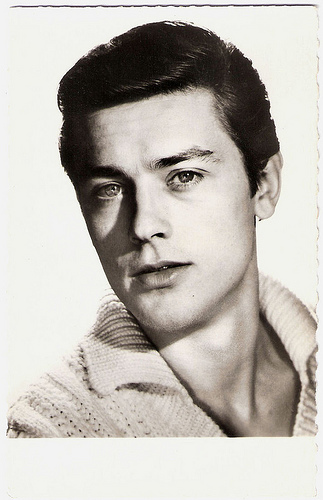
French postcard by Editions P.I., no. 1004. Offered by Les Carbones Korès 'Carboplane'. Photo: Sam Lévin.
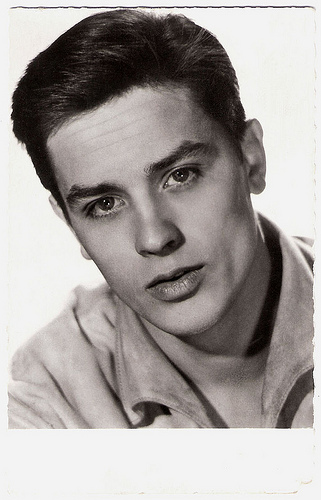
French postcard by Editions P.I., no. 1026. Photo: Sam Lévin.
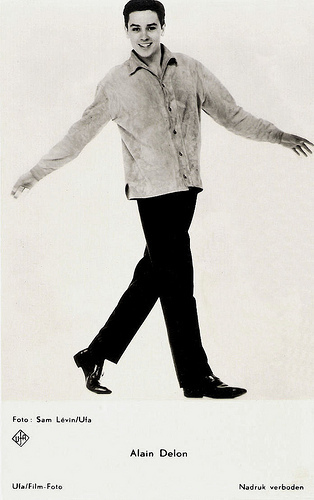
Belgian postcard by D.R.C, licency holder for Belgium and Belgian Congo of Universum Film Aktiengesellschaft, Berlin-Tempelhof, no. 4615. Photo: Sam Lévin / Ufa.
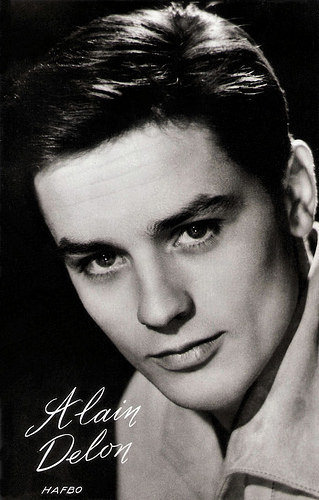
Dutch postcard by Muziekparade, Hilversum, no. AX 4701. Photo: Hafbo / Sam Lévin.
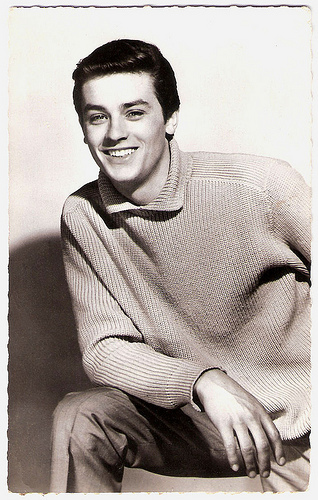
French postcard by Editions du Globe (EDUG), Paris, no. 838. Photo: Sam Lévin.
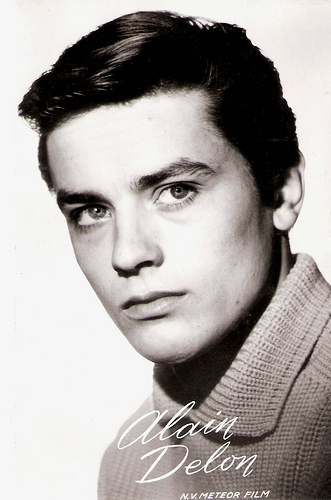
Dutch postcard by Uitg. Takken, Utrecht, no. 3980. Photo: N.V. Meteor Film / Speva / Play Art Prod. Publicity still for Christine/Liebelei (Pierre Gaspard-Huit, 1958).
The Eclipse
Luchino Visconti offered Alain Delon a totally different role in Rocco e i suoi fratelli/Rocco and His Brothers (Luchino Visconti, 1960). In this film, he plays the devoted Sicilian immigrant Rocco, who accepts the greatest sacrifices to save his characterless brother Simone, played by Renato Salvatori. Delon received international recognition for this role.
The following year Alain Delon made his stage debut in Paris in Dommage qu'elle soit une putain/'Tis Pity She’s a Whore, alongside Romy Schneider . The play, written by John Ford, was directed by Luchino Visconti. The production cost a reported 60 million francs and broke box office records. It ran for more than 8 months.
Delon also gave tremendous performances in L'Eclisse/The Eclipse (Michelangelo Antonioni, 1962) opposite Monica Vitti , and the epic Il Gattopardo/The Leopard (Luchino Visconti, 1963) starring opposite Burt Lancaster and Claudia Cardinale . L’Eclisse won the Special Prize of the jury at the Cannes Film Festival, and the following year Il Gattopardo won the Golden Palm in Cannes.
After these acclaimed Italian films, Alain Delon returned to France and to the crime film in Mélodie en sous-sol/The Big Snatch (Henri Verneuil, 1963), with Jean Gabin . This classic genre film was distinguished by a soundly worked-out screenplay, by careful production and by excellent performances of both Gabin and Delon.
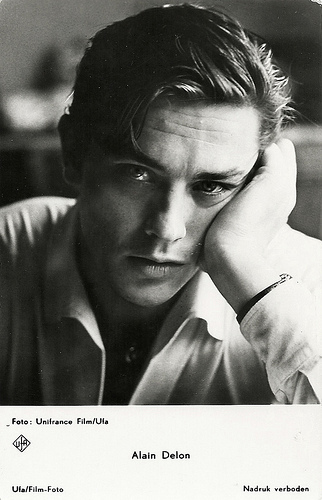
Dutch postcard by Gebr. Spanjersberg, Rotterdam, no. 1383. Photo: Unifrance Film / Ufa.
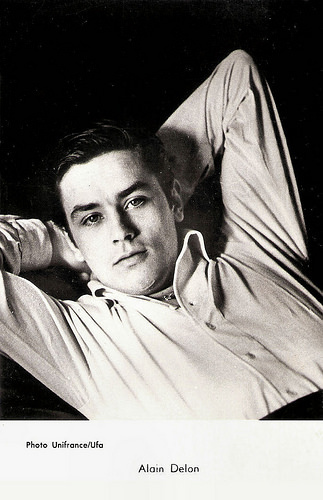
French postcard by Editions P.I., Paris, no. FK 44. Photo: Unifrance / Ufa.
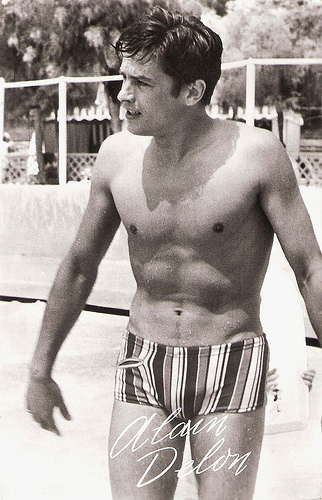
Dutch postcard by 't Sticht, Utrecht, no. 6176.
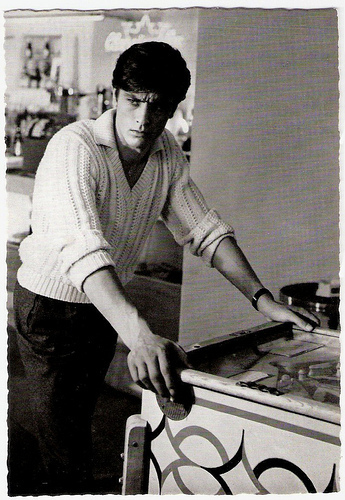
German postcard by WS-Druck, Wanne-Eickel, no. 444. Photo: Privat.
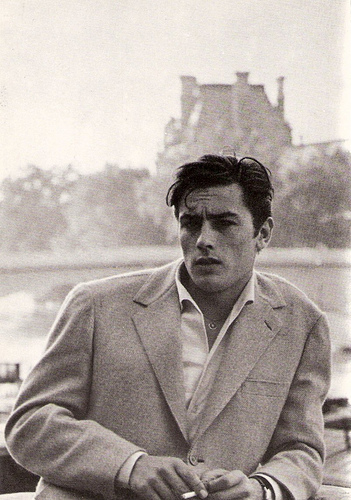
French postcard by Editions P.I., Paris, no. FK 42. Photo: Unifrance Film / Philippe R. Doumic.
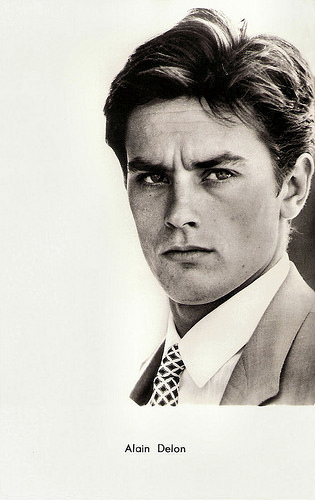
French postcard by Editions P.I., no. 1151A, offered by Les Carbones Korès 'Carboplane.
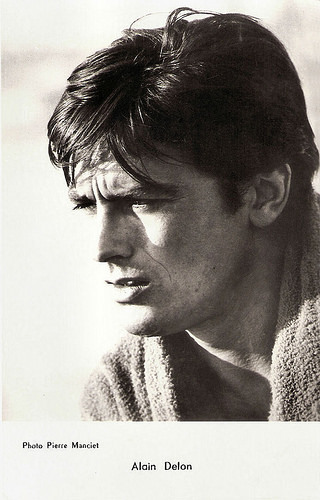
French postcard by Editions P.I., no. 1161, offered by Les Carbones Korès 'Carboplane. Photo: Pierre Manciet.
A bid for American stardom
By now Hollywood studios were very interested in Alain Delon and he decided to make a bid for American stardom. In 1965, MGM signed him to a five picture contract. The first movie of this deal was Les Félins/Joy House (René Clément, 1964), shot in France with Jane Fonda. He followed it up with two more films for the studio: the all-star The Yellow Rolls Royce (Anthony Asquith, 1965), in which Delon had a relatively small role, and Once a Thief (Ralph Nelson, 1965), where he co-starred with Ann-Margret.
Delon then signed a three picture deal with Columbia. He appeared for this studio in the big budget action film Lost Command (Mark Robson, 1966) with Anthony Quinn. Universal Studios used Delon in the Western Texas Across the River (Michael Gordon, 1966), opposite Dean Martin.
For Seven Arts, Delon starred in Paris brûle-t-il?/Is Paris Burning? (René Clément, 1966) about the liberation of Paris in August 1944 by the French Resistance and the Free French Forces. This was a massive hit in France but it performed disappointingly at the US box office - as did all of Delon's Hollywood financed films. So after six Hollywood movies Delon returned to France.
In the late sixties, Delon came to epitomise the calm, psychopathic hoodlum, staring into the camera like a cat assessing a mouse. His tough, ruthless side was used to grand effect in Le Samouraï/The Godson (Jean-Pierre Melville, 1967), maybe Delon’s finest moment. Later Melville directed him again in the crime films Le Cercle Rouge/The Red Circle (1970) with Bourvil and Yves Montand , and Un Flic/A Cop (1972) with Catherine Deneuve .
In 1968 Delon also in real life got involved in a murder scandal when one of his bodyguard was found shot dead on a garbage dump nearby Delon's house. Eventually Delon was cleared of all charges.
In the cinema, Alain Delon had a huge success in the bloodstained Borsalino (Jacques Deray, 1970). He and Jean-Paul Belmondo played small-time gangsters who become kings of the Marseilles underworld of the 1930s. He also produced Borsalino, and the film became one of France’s highest grossing films of the time. Between 1968 and 1990 he went on to produce 26 films.
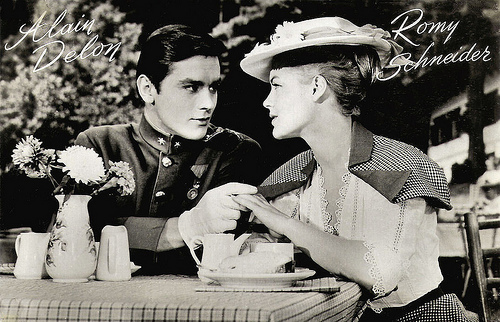
Dutch postcard by Takken, Utrecht. Photo: NV Meteor Film. Publicity still for Christine/Liebelei (Pierre Gaspard-Huit, 1958) with Romy Schneider .
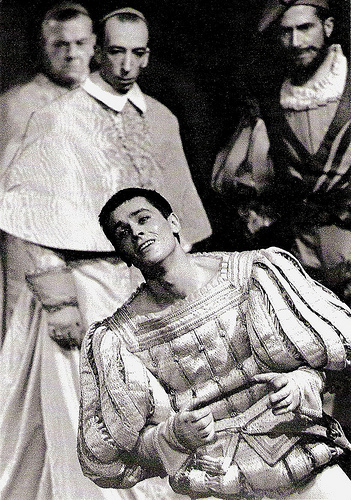
French postcard by the Bibliothèque Nationale Paris / Imp. Bussière A.G., Paris, 1990. Photo: Roger Pic. Alain Delon in the play Dommage qu'elle soit une p.../'Tis Pity She’s a Whore directed by Luchino Visconti (1961).
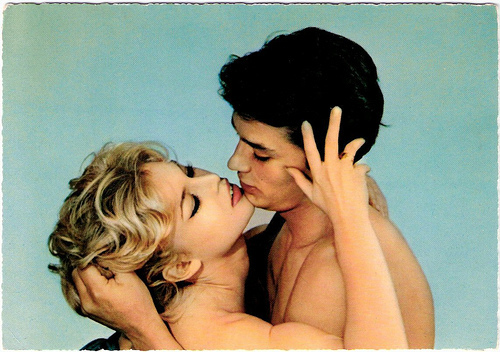
German postcard by Krüger, no. 902/95. Photo Sam Lévin. Another sexy publicity photo for Amours célèbres (Michel Boisrond, 1961) with Brigitte Bardot .

Small Romanian collectors card by Casa Filmului Acin. Photo: publicity still for L'eclisse/The Eclypse (Michelangelo Antonioni, 1962) with Monica Vitti.
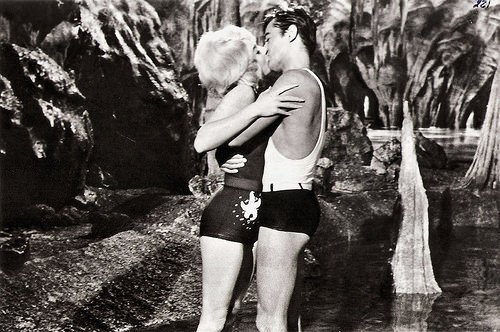
Romanian postcard by Casa Filmului Acin, no. 313. Photo: publicity still for The Yellow Rolls-Royce (Anthony Asquith, 1964) with Shirley MacLaine.
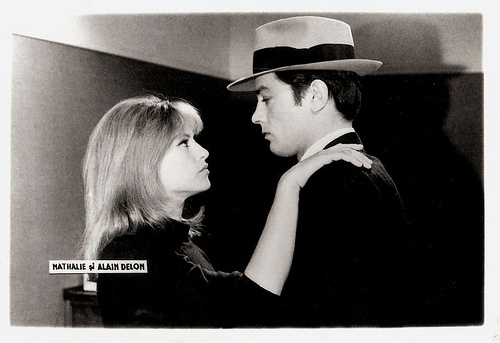
Small Romanian collectors card. Photo: publicity still for Le Samouraï (Jean-Pierre Melville, 1967) with Nathalie Delon .
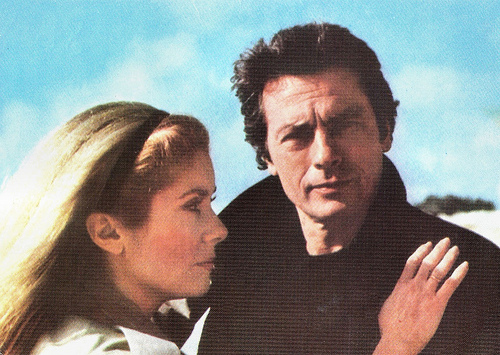
Romanian postcard by Casa Filmului Acin. Photo: publicity still for Le choc/Shock (Robin Davis, 1982) with Catherine Deneuve.
Roles Against Type
In later years Alain Delon won critical acclaim for roles against type. In the Kafkaesk thriller Mr Klein (Joseph Losey, 1976) he was brilliant as the icily sinister art trader in German-occupied France.
In 1985 he was awarded the César Award as Best Actor for his role as an alcoholic in Notre histoire/Our Story (Bertrand Blier, 1984). Another acclaimed role was the homosexual Baron de Charlus in the fine Marcel Proust adaptation Un amour de Swann/Swann in Love (Volker Schlöndorf, 1984).
And in 1990, Delon worked with New Wave auteur Jean-Luc Godard on Nouvelle vague/New Wave (1990), in which he played twins. He also directed two films himself, Pour la peau d'un flic/For a Cop's Hide (1981) and Le Battant/The Fighter (1983).
A string of box office disasters in the next years culminated in 1998 in the unexpected failure of Une chance sur deux/Half a Chance (Patrice Leconte, 1998) in which Alain Delon was reunited with Jean-Paul Belmondo . Delon announced that he would give up acting. For his impressive film career he received the Legion d'Honneur, the highest French decoration.
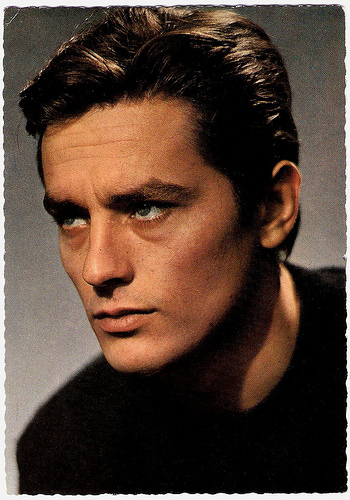
French postcard by E.D.U.G., no. 469. Photo: Sam Lévin.
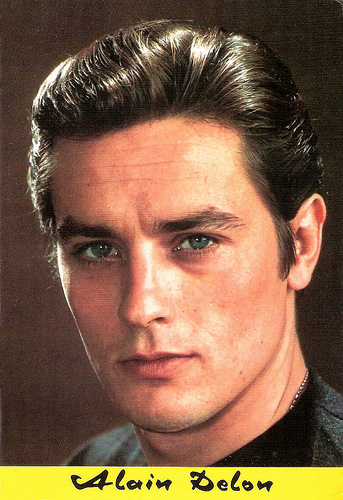
Spanish postcard by Bergas Ind. Graf., no. 572.
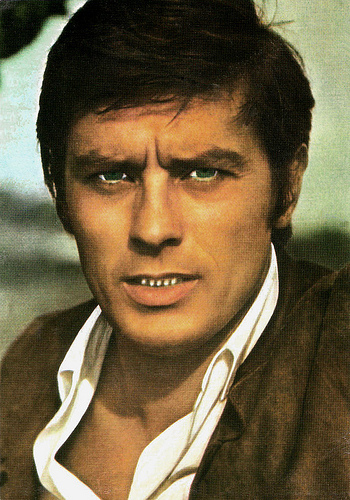
Romanian postcard by Casa Filmului Acin.
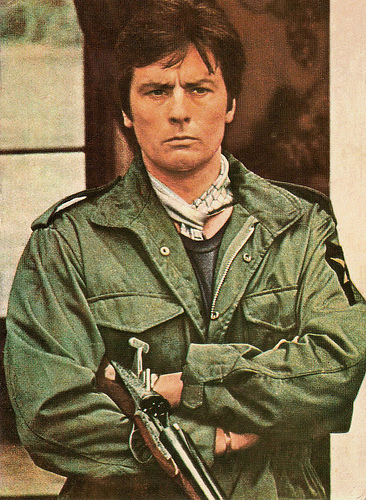
Romanian postcard by Casa Filmului Acin.
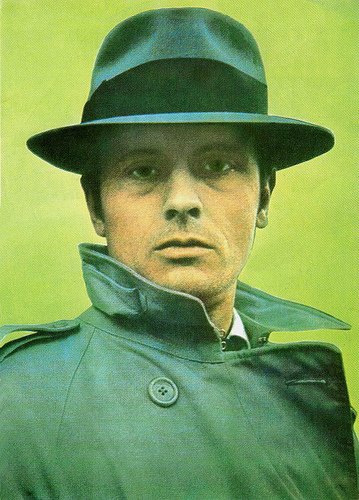
Romanian postcard by Casa Filmului Acin.
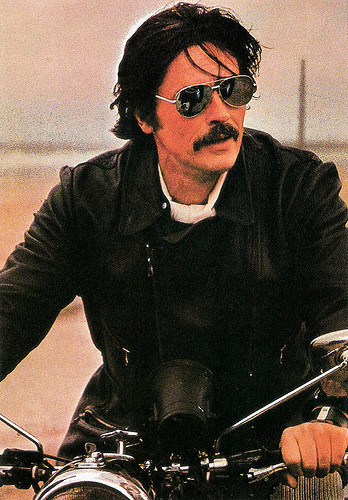
French postcard by Editions F. Nugeron, no. Star 28.
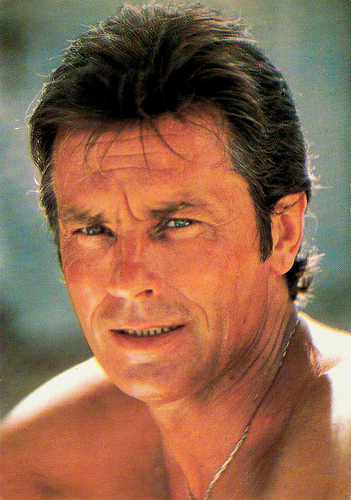
French postcard by Editions P.I., Paris, no. 3453. Photo: Michel Ginfray.
Astérix
Alain Delon returned in the cinema as Julius Cesar in Astérix aux Jeux Olympiques/Asterix at the Olympic Games (Frederic Forestier, Thomas Langmann, 2008), and he reunited with former girlfriend Mireille Darc in a stage adaptation of The Bridges of Madison County by Robert James Waller at the Marigny Theatre in Paris.
Alain Delon has a son, Christian Aaron Boulogne 'Ari' Päffgen (1962), from a relationship with German singer/supermodel Nico. The child was raised mostly by Delon's mother and stepfather. He broke the relationship with his mother after she insisted on taking care of Ari. They spoke again when his step-father died in 1988, the same year Nico died.
From his first marriage to Nathalie Delon (Nathalie Barthélemy) he has another son, Anthony Delon (1964), who also acted in a number of films. Then he was a longtime companion of actress Mireille Darc from 1968 to 1982. Then he had a relationship with Anne Parillaud. From his second marriage with former Dutch model Rosalie van Breemen he has a son Alain-Fabien (1990) and a daughter Anouchka (1994). Rosalie was 21 when she met Alain who was 52. They lived together from 1987 till 2001.
Today, Alain Delon lives in Geneva, Switzerland. He acquired Swiss citizenship in 1999, and the company managing products sold under his name is based in Geneva. Since the formation of a perfume label in his name, Delon has had a variety of products sold under his name including wristwatches, clothing, eyewear, stationery and cigarettes.
His most recent film appearance was in the Russian comedy S Novym godom, mamy!/Happy New Year, Mommies! (Artyom Aksyonenko, Sarik Andreasyan, Anton Bormatov, Dmitriy Grachev, Klim Poplavskiy, 2012).
Trailer Rocco e i suoi fratelli/Rocco and his Brothers (1960). Source: Filmmuseum Amsterdam (YouTube).
Trailer for Mélodie en sous-sol/The Big Snatch (1963). Source: Curtis Hayden (YouTube).
Trailer Le Samouraï/The Godson (1967). Source: Edwin Nieves (YouTube).
Trailer La Piscine/The Pool (1968). Source: Filmmuseum Amsterdam (YouTube).
Sources: Alain Delon.ch, Wikipedia, (IMDb), Il Cinema Ritrovato and .
A highlight at Il Cinema Ritrovato 2015 is the open-air screening tonight of Rocco e i suoi fratelli/Rocco and His Brothers (Luchino Visconti, 1960) in a magical black and white, thanks to a new restoration. Today's post is about Alain Delon (1935), the actor who played Rocco in this landmark Italian film. Delon was the breathtakingly good-looking James Dean of the European cinema of the late 1950s and early 1960s who proved in this film that he was also a magnificent actor.

East-German postcard by VEB Progress Film-Vertrieb, Berlin, 1967. retail price: 0,20 MDN.Photo: publicity still for Rocco e i suoi fratelli/Rocco and his brothers (Luchino Visconti, 1960).

French postcard by E.D.U.G., no. 22. Photo: Sam Lévin.

German postcard by Krüger. Photo: Ufa.

German postcard by ISV, no. H 25.

French postcard by St. Anne, Marseille. Photo: Sam Lévin.

Spanish postcard, no. 161. Photo: Philippe R. Doumic.

Spanish postcard by Bergas Ind. Graf., Barcelona, no. 463, 1967.
Stormy Childhood
Alain Fabien Maurice Marcel Delon was born in Sceaux, a suburb of Paris in 1935. His parents, Édith Arnold and Fabien Delon, divorced when Delon was four. He had a stormy childhood and was six times expelled from different schools.
At 14, Delon left school, and worked for a brief time at his stepfather Paul Boulogne's butcher shop. Three years later, the 17-year-old enlisted in the French Marines, serving in 1953-1954 in Indochina as a parachutist. In 1956, after being dishonourably discharged from the military, he returned to France. He had little money and worked at various odd jobs, including as a waiter, salesman, and porter in the Les Halles market.
During this time he became friends with the actress Brigitte Auber , and joined her on a trip to the Cannes Film Festival, where his film career would begin with a screentest for David O’Selznick. He didn't go to Hollywood, but decided to stay in France. He made his film debut in Quand la femmes s'en mele/Send a Woman When the Devil Fails (Yves Allégret, 1957).
In 1958, during the making of the love story Christine (Pierre Gaspard-Huit, 1959), Delon met Romy Schneider . They would be engaged till 1964.
Delon’s first outstanding success came with the role of the parasite Tom Ripley in the sundrenched thriller Plein soleil/Purple Noon (René Clément, 1960), based on the crime novel The Talented Mr. Ripley by Patricia Highsmith. Delon presented a psychological portrait of a murderous young cynic who attempts to take on the identity of his victim. The critics liked his performance. According to Wikipedia , Patricia Highsmith herself was also a fan of his portrayal.

German postcard by WS-Druck, Wanne Eickel, no. 419. Photo: Sam Lévin, 1957.

French postcard by Editions P.I., no. 1004. Offered by Les Carbones Korès 'Carboplane'. Photo: Sam Lévin.

French postcard by Editions P.I., no. 1026. Photo: Sam Lévin.

Belgian postcard by D.R.C, licency holder for Belgium and Belgian Congo of Universum Film Aktiengesellschaft, Berlin-Tempelhof, no. 4615. Photo: Sam Lévin / Ufa.

Dutch postcard by Muziekparade, Hilversum, no. AX 4701. Photo: Hafbo / Sam Lévin.

French postcard by Editions du Globe (EDUG), Paris, no. 838. Photo: Sam Lévin.

Dutch postcard by Uitg. Takken, Utrecht, no. 3980. Photo: N.V. Meteor Film / Speva / Play Art Prod. Publicity still for Christine/Liebelei (Pierre Gaspard-Huit, 1958).
The Eclipse
Luchino Visconti offered Alain Delon a totally different role in Rocco e i suoi fratelli/Rocco and His Brothers (Luchino Visconti, 1960). In this film, he plays the devoted Sicilian immigrant Rocco, who accepts the greatest sacrifices to save his characterless brother Simone, played by Renato Salvatori. Delon received international recognition for this role.
The following year Alain Delon made his stage debut in Paris in Dommage qu'elle soit une putain/'Tis Pity She’s a Whore, alongside Romy Schneider . The play, written by John Ford, was directed by Luchino Visconti. The production cost a reported 60 million francs and broke box office records. It ran for more than 8 months.
Delon also gave tremendous performances in L'Eclisse/The Eclipse (Michelangelo Antonioni, 1962) opposite Monica Vitti , and the epic Il Gattopardo/The Leopard (Luchino Visconti, 1963) starring opposite Burt Lancaster and Claudia Cardinale . L’Eclisse won the Special Prize of the jury at the Cannes Film Festival, and the following year Il Gattopardo won the Golden Palm in Cannes.
After these acclaimed Italian films, Alain Delon returned to France and to the crime film in Mélodie en sous-sol/The Big Snatch (Henri Verneuil, 1963), with Jean Gabin . This classic genre film was distinguished by a soundly worked-out screenplay, by careful production and by excellent performances of both Gabin and Delon.

Dutch postcard by Gebr. Spanjersberg, Rotterdam, no. 1383. Photo: Unifrance Film / Ufa.

French postcard by Editions P.I., Paris, no. FK 44. Photo: Unifrance / Ufa.

Dutch postcard by 't Sticht, Utrecht, no. 6176.

German postcard by WS-Druck, Wanne-Eickel, no. 444. Photo: Privat.

French postcard by Editions P.I., Paris, no. FK 42. Photo: Unifrance Film / Philippe R. Doumic.

French postcard by Editions P.I., no. 1151A, offered by Les Carbones Korès 'Carboplane.

French postcard by Editions P.I., no. 1161, offered by Les Carbones Korès 'Carboplane. Photo: Pierre Manciet.
A bid for American stardom
By now Hollywood studios were very interested in Alain Delon and he decided to make a bid for American stardom. In 1965, MGM signed him to a five picture contract. The first movie of this deal was Les Félins/Joy House (René Clément, 1964), shot in France with Jane Fonda. He followed it up with two more films for the studio: the all-star The Yellow Rolls Royce (Anthony Asquith, 1965), in which Delon had a relatively small role, and Once a Thief (Ralph Nelson, 1965), where he co-starred with Ann-Margret.
Delon then signed a three picture deal with Columbia. He appeared for this studio in the big budget action film Lost Command (Mark Robson, 1966) with Anthony Quinn. Universal Studios used Delon in the Western Texas Across the River (Michael Gordon, 1966), opposite Dean Martin.
For Seven Arts, Delon starred in Paris brûle-t-il?/Is Paris Burning? (René Clément, 1966) about the liberation of Paris in August 1944 by the French Resistance and the Free French Forces. This was a massive hit in France but it performed disappointingly at the US box office - as did all of Delon's Hollywood financed films. So after six Hollywood movies Delon returned to France.
In the late sixties, Delon came to epitomise the calm, psychopathic hoodlum, staring into the camera like a cat assessing a mouse. His tough, ruthless side was used to grand effect in Le Samouraï/The Godson (Jean-Pierre Melville, 1967), maybe Delon’s finest moment. Later Melville directed him again in the crime films Le Cercle Rouge/The Red Circle (1970) with Bourvil and Yves Montand , and Un Flic/A Cop (1972) with Catherine Deneuve .
In 1968 Delon also in real life got involved in a murder scandal when one of his bodyguard was found shot dead on a garbage dump nearby Delon's house. Eventually Delon was cleared of all charges.
In the cinema, Alain Delon had a huge success in the bloodstained Borsalino (Jacques Deray, 1970). He and Jean-Paul Belmondo played small-time gangsters who become kings of the Marseilles underworld of the 1930s. He also produced Borsalino, and the film became one of France’s highest grossing films of the time. Between 1968 and 1990 he went on to produce 26 films.

Dutch postcard by Takken, Utrecht. Photo: NV Meteor Film. Publicity still for Christine/Liebelei (Pierre Gaspard-Huit, 1958) with Romy Schneider .

French postcard by the Bibliothèque Nationale Paris / Imp. Bussière A.G., Paris, 1990. Photo: Roger Pic. Alain Delon in the play Dommage qu'elle soit une p.../'Tis Pity She’s a Whore directed by Luchino Visconti (1961).

German postcard by Krüger, no. 902/95. Photo Sam Lévin. Another sexy publicity photo for Amours célèbres (Michel Boisrond, 1961) with Brigitte Bardot .

Small Romanian collectors card by Casa Filmului Acin. Photo: publicity still for L'eclisse/The Eclypse (Michelangelo Antonioni, 1962) with Monica Vitti.

Romanian postcard by Casa Filmului Acin, no. 313. Photo: publicity still for The Yellow Rolls-Royce (Anthony Asquith, 1964) with Shirley MacLaine.

Small Romanian collectors card. Photo: publicity still for Le Samouraï (Jean-Pierre Melville, 1967) with Nathalie Delon .

Romanian postcard by Casa Filmului Acin. Photo: publicity still for Le choc/Shock (Robin Davis, 1982) with Catherine Deneuve.
Roles Against Type
In later years Alain Delon won critical acclaim for roles against type. In the Kafkaesk thriller Mr Klein (Joseph Losey, 1976) he was brilliant as the icily sinister art trader in German-occupied France.
In 1985 he was awarded the César Award as Best Actor for his role as an alcoholic in Notre histoire/Our Story (Bertrand Blier, 1984). Another acclaimed role was the homosexual Baron de Charlus in the fine Marcel Proust adaptation Un amour de Swann/Swann in Love (Volker Schlöndorf, 1984).
And in 1990, Delon worked with New Wave auteur Jean-Luc Godard on Nouvelle vague/New Wave (1990), in which he played twins. He also directed two films himself, Pour la peau d'un flic/For a Cop's Hide (1981) and Le Battant/The Fighter (1983).
A string of box office disasters in the next years culminated in 1998 in the unexpected failure of Une chance sur deux/Half a Chance (Patrice Leconte, 1998) in which Alain Delon was reunited with Jean-Paul Belmondo . Delon announced that he would give up acting. For his impressive film career he received the Legion d'Honneur, the highest French decoration.

French postcard by E.D.U.G., no. 469. Photo: Sam Lévin.

Spanish postcard by Bergas Ind. Graf., no. 572.

Romanian postcard by Casa Filmului Acin.

Romanian postcard by Casa Filmului Acin.

Romanian postcard by Casa Filmului Acin.

French postcard by Editions F. Nugeron, no. Star 28.

French postcard by Editions P.I., Paris, no. 3453. Photo: Michel Ginfray.
Astérix
Alain Delon returned in the cinema as Julius Cesar in Astérix aux Jeux Olympiques/Asterix at the Olympic Games (Frederic Forestier, Thomas Langmann, 2008), and he reunited with former girlfriend Mireille Darc in a stage adaptation of The Bridges of Madison County by Robert James Waller at the Marigny Theatre in Paris.
Alain Delon has a son, Christian Aaron Boulogne 'Ari' Päffgen (1962), from a relationship with German singer/supermodel Nico. The child was raised mostly by Delon's mother and stepfather. He broke the relationship with his mother after she insisted on taking care of Ari. They spoke again when his step-father died in 1988, the same year Nico died.
From his first marriage to Nathalie Delon (Nathalie Barthélemy) he has another son, Anthony Delon (1964), who also acted in a number of films. Then he was a longtime companion of actress Mireille Darc from 1968 to 1982. Then he had a relationship with Anne Parillaud. From his second marriage with former Dutch model Rosalie van Breemen he has a son Alain-Fabien (1990) and a daughter Anouchka (1994). Rosalie was 21 when she met Alain who was 52. They lived together from 1987 till 2001.
Today, Alain Delon lives in Geneva, Switzerland. He acquired Swiss citizenship in 1999, and the company managing products sold under his name is based in Geneva. Since the formation of a perfume label in his name, Delon has had a variety of products sold under his name including wristwatches, clothing, eyewear, stationery and cigarettes.
His most recent film appearance was in the Russian comedy S Novym godom, mamy!/Happy New Year, Mommies! (Artyom Aksyonenko, Sarik Andreasyan, Anton Bormatov, Dmitriy Grachev, Klim Poplavskiy, 2012).
Trailer Rocco e i suoi fratelli/Rocco and his Brothers (1960). Source: Filmmuseum Amsterdam (YouTube).
Trailer for Mélodie en sous-sol/The Big Snatch (1963). Source: Curtis Hayden (YouTube).
Trailer Le Samouraï/The Godson (1967). Source: Edwin Nieves (YouTube).
Trailer La Piscine/The Pool (1968). Source: Filmmuseum Amsterdam (YouTube).
Sources: Alain Delon.ch, Wikipedia, (IMDb), Il Cinema Ritrovato and .
Published on August 15, 2018 22:00
August 14, 2018
5 million pageviews for EFSP - Marina Vlady
The pageview teller of European Film Star Postcards passed the 5,000,000 on 11 August 2018. We commemorate this milestone with updates of our five most popular posts of all times. Today number 2, Marina Vlady, last updated on 7 July 2012. It had 13,785 page views. This summer, Ms. Vlady attended a screening of one her first films, Giorni d'amore/Days of Love (Giuseppe de Santis, 1954), at Cinema Ritrovato in Bologna, where we took a snapshot which we added to this post.
Sensual and alluring French star Marina Vlady (1938) had the makings of just another blonde bombshell, but in 1963 she stunned everybody with her performance in L’Ape Regine/The Conjugal Bed. At the Cannes Film Festival the feline beauty won that year the Golden Palm for Best Actress.
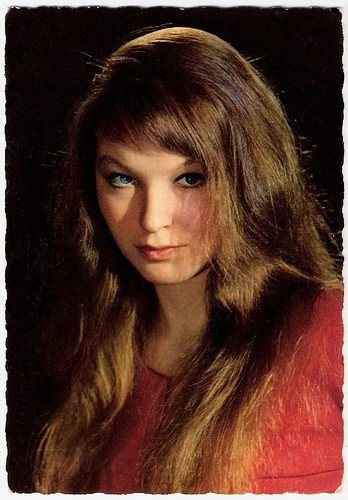
French postcard by E.D.U.G., no. 74. Photo: Sam Lévin.
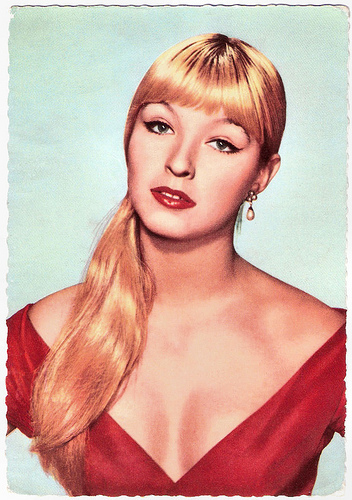
German postcard by Ufa, Berlin-Tempelhof, no. CK-76. Photo: Unifrance Film.
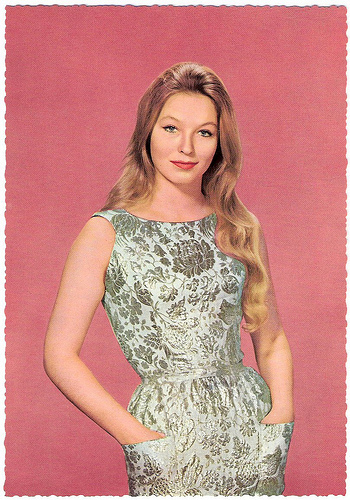
German postcard by Krüger.
Vision of Loveliness
Marina Vlady was born Marina De Poliakoff-Baidaroff in Clichy, France, as the daughter of a noted, Russian born painter and opera singer Vladimir de Poliakof and star dancer Militza Envald. She is the youngest sister of the actresses Odile Versois , Hélène Vallier, and Olga Baïdar-Poliakoff.
Like her siblings, she began acting as a child and for a while she pursued a ballet career. Marina and Olga both made their minor film debuts in Orage d'été/Summer Storm (Jean Gehret, 1949) which featured their sister Odile.
Marina caught the eye of talent agents. She was a vision of loveliness alongside Marcello Mastroianni in the touching WW II drama Penne nere/Black Feathers (Oreste Biancoli, 1952).
The following year, she co-starred with Italy's top character actor Aldo Fabrizi as his daughter in L’età dell'amore/Too Young for Love (Lionello De Felice, 1953).
In 1955, at the ripe young age of 17, Vlady met and married actor-writer-director Robert Hossein , who featured her prominently and seductively in a number of his films.
These films included Les salauds vont en enfer/The Wicked Go to Hell (Robert Hossein, 1956) as a femme fatale bent on revenge, Pardonnez nos offenses(Robert Hossein, 1956), La nuit des espions/Double Agents (Robert Hossein, 1959), and notably, Toi, le venin/Nude in a White Car (Robert Hossein, 1958) which co-starred her sister Odile.
With her sensual and alluring image Marina Vlady gained international renown. The marriage with Hossein lasted only a few years.
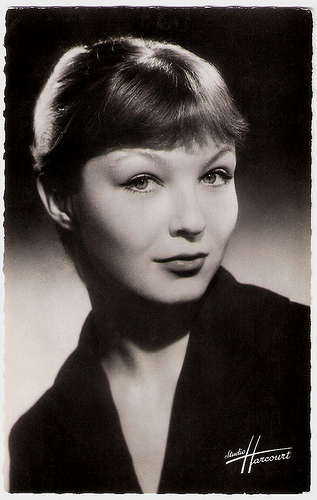
French postcard by Editions du Globe (E.D.U.G.), Paris, no. 470. Photo: Studio Harcourt.
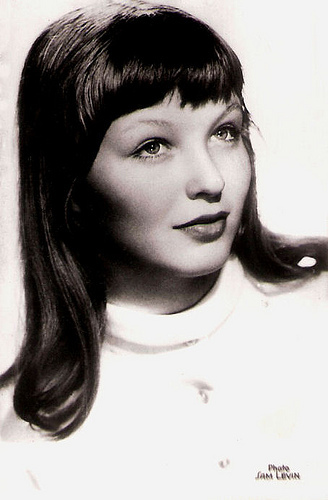
Collectors card. Photo: Sam Lévin.
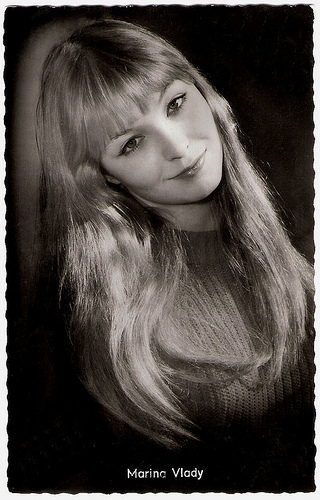
German postcard by Kolibri-Verlag G.m.b.H., Minden/Westf., no. 2476. Photo: Cinepress / Stempka.

East-German postcard by VEB Progress Film-Vertrieb, Berlin, no. 1842, 1963. Retail price: 0,20 DM. Publicity still for La liberté surveillée/Provisional Liberty (1958, Henri Aisner, Vladimír Vlcek) with Robert Hossein .
Sexually Insatiable Wife
Marina Vlady could have ended up in the film history annals as merely a second-rate Brigitte Bardot , but the provocative sex kitten proved that she was capable of much more.
In 1961 her role in the costume drama La Princesse de Clèves/Princess of Cleves (Jean Delannoy, 1961) at the side of Jean Marais was reviewed favorably.
In 1963 she gave a stunning performance as the sexually insatiable wife in L’Ape Regine/The Conjugal Bed (Marco Ferreri, 1963) opposite Ugo Tognazzi. She was nominated for a Golden Globe, and won the Best Actress Award at the 1963 Cannes Film Festival.
She also starred in Godard’s essay on Paris, prostitution and cinema, 2 ou 3 choses que je sais d'elle/Two or Three Things I Know About Her (Jean-Luc Godard, 1967).
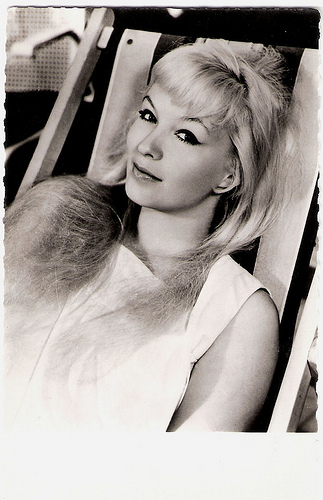
French postcard by Editions P.I., Paris, offered by Les Carbones Korès 'Carboplane, no. 950. Photo: Studio Bernard & Vauclair.
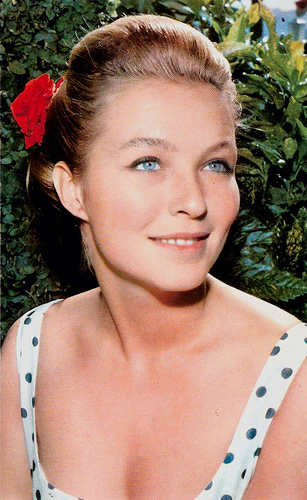
French postcard by Editions P.I., Paris, no. 1093. Photo: Ektachrome Anders. This postcard was offered by Corvisart (a biscuit factory), Epinal.
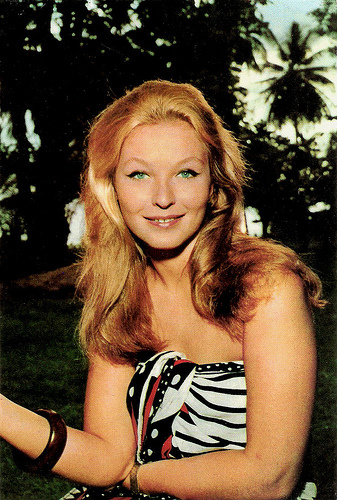
Israelian postcard by Editions de Luxe, no. 120.
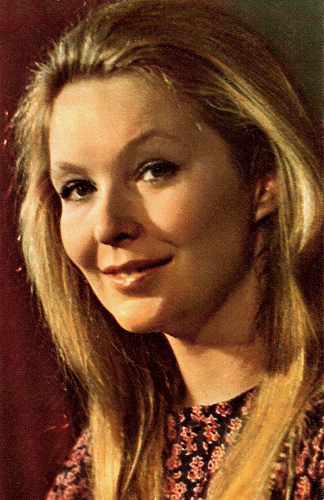
Russian postcard by Izdanije Byuro Propogandy Sovietskogo Kinoiskusstva, no. 3624, 1975. This postcard was printed in an edition of 200.000 cards. Retail price: 5 kop.
Caustic Characters
Gracing both French and Italian productions throughout most of her career, Marina Vlady was not shy at playing unsympathetic, even caustic characters, and proved adept at both saucy comedy and edgy drama.
One of her rare English roles was Kate Percy in the William Shakespeare adaptation Campanadas a medianoche/Chimes at Midnight (Orson Welles, 1965).
In 1967 she played at the Théâtre Hébertot in Paris with her three sisters, Hélène Vallier, Odile Versois , and Olga Poliakoff, and they had 250 performances.
Her later films included Ök ketten/The Two of Them (Márta Mészarós, 1977), Tangos, l'exil de Gardel/Tangos, the Exile of Gardel (Fernando Solanas, 1985), Splendor (Ettore Scola, 1989), and she also worked a lot for TV. Five years later followed Jeunesse/Youth (Noel Alpi, 1995).
In 2011 she returned to the screen in the French-Algerian film Quelques jours de répit/A Few Days of Respite (Amor Hakkar, 2011). It competed in the World Cinema section at the 2011 Sundance Film Festival. Recently, she could be seen in the short film, L'air d'un oubli/Maxence & Clara (Olivier Fely-Biolet, 2016) and gave her voice to another short, La lettre à Noémie/The Letter to Noémie (Micheline Abergel, Natasha Mashkevich, 2017).
Marina Vlady was married four times. She has two sons with Robert Hossein, Igor and Pierre Her second husband was Jean-Claude Brouillet.
In 1969 (or 1970 - the sources differ about the date) she married Russian poet, song-writer and actor Vladimir Vysotsky, who died in 1980 of a drug overdose aggravated by chronic alcoholism. About their love affair she wrote the memoir Vladimir, or the Aborted Flight. Her fourth husband, doctor Léon Schwartzenberg, passed away in 2003.
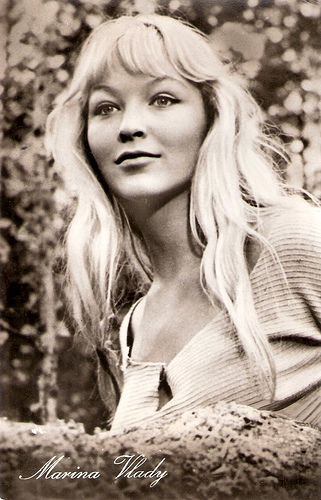
East-German card by VEB Progress Film-Vertrieb, Berlin. Photo: Les Films Metzger & Woog und Productions Iena, no. 1/457. Still from La Sorcière/The Blonde Witch (André Michel, 1956). In this film Marina Vlady plays Ina, a Swedish nature-girl, who meets Brulard, a French civil engineer on assignment in Sweden for a lumber company. They fall in love, and have an affair. He tries to convert her to 'civilization', but ends up getting her killed by superstitious villagers instead.
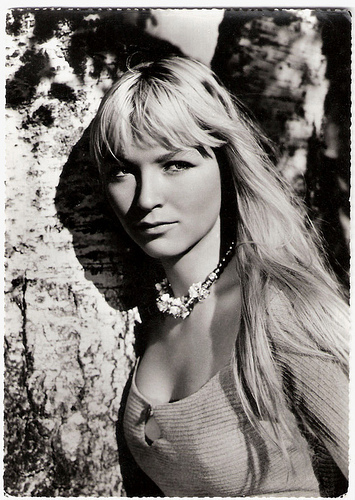
Serbian postcard by ZK, no. 2183. Sent by mail in 1961.
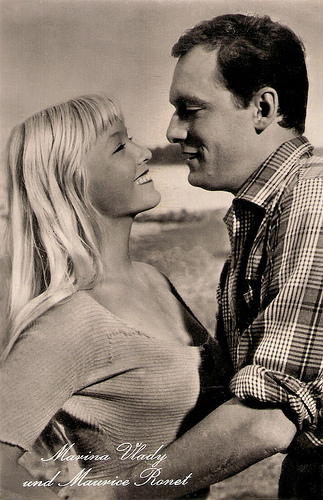
East-German card by VEB Progress Film-Vertrieb, Berlin. Retail price: 0,20 DM. Photo: Les Films Metzger & Woog u. Productions Iena, no. 1.375, 1957. Still from La Sorcière/The Blonde Witch (André Michel, 1956), with Maurice Ronet .
Scene with Marina Vlady and Maurice Ronet in La Sorcière/The Blonde Witch (André Michel, 1956). Source: Jinochka (YouTube).
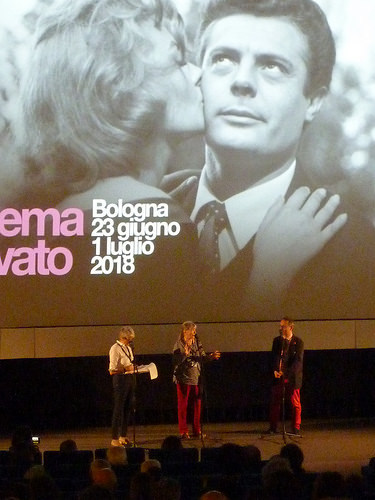
Marina Vlady was one of the guests at Cinema Ritrovato 2018. Here, she is interviewed by festival director Gian Luca Farinelli before the screening of Giorni d'amore/Days of Love (Giuseppe de Santis, 1954) at the Cinema Arlecchino. She was funny and very alert and looked amazing.
Sources: (IMDb), Hal Erickson (AllMovie), Ciné-Ressources (French), Wikipedia, and .
Sensual and alluring French star Marina Vlady (1938) had the makings of just another blonde bombshell, but in 1963 she stunned everybody with her performance in L’Ape Regine/The Conjugal Bed. At the Cannes Film Festival the feline beauty won that year the Golden Palm for Best Actress.

French postcard by E.D.U.G., no. 74. Photo: Sam Lévin.

German postcard by Ufa, Berlin-Tempelhof, no. CK-76. Photo: Unifrance Film.

German postcard by Krüger.
Vision of Loveliness
Marina Vlady was born Marina De Poliakoff-Baidaroff in Clichy, France, as the daughter of a noted, Russian born painter and opera singer Vladimir de Poliakof and star dancer Militza Envald. She is the youngest sister of the actresses Odile Versois , Hélène Vallier, and Olga Baïdar-Poliakoff.
Like her siblings, she began acting as a child and for a while she pursued a ballet career. Marina and Olga both made their minor film debuts in Orage d'été/Summer Storm (Jean Gehret, 1949) which featured their sister Odile.
Marina caught the eye of talent agents. She was a vision of loveliness alongside Marcello Mastroianni in the touching WW II drama Penne nere/Black Feathers (Oreste Biancoli, 1952).
The following year, she co-starred with Italy's top character actor Aldo Fabrizi as his daughter in L’età dell'amore/Too Young for Love (Lionello De Felice, 1953).
In 1955, at the ripe young age of 17, Vlady met and married actor-writer-director Robert Hossein , who featured her prominently and seductively in a number of his films.
These films included Les salauds vont en enfer/The Wicked Go to Hell (Robert Hossein, 1956) as a femme fatale bent on revenge, Pardonnez nos offenses(Robert Hossein, 1956), La nuit des espions/Double Agents (Robert Hossein, 1959), and notably, Toi, le venin/Nude in a White Car (Robert Hossein, 1958) which co-starred her sister Odile.
With her sensual and alluring image Marina Vlady gained international renown. The marriage with Hossein lasted only a few years.

French postcard by Editions du Globe (E.D.U.G.), Paris, no. 470. Photo: Studio Harcourt.

Collectors card. Photo: Sam Lévin.

German postcard by Kolibri-Verlag G.m.b.H., Minden/Westf., no. 2476. Photo: Cinepress / Stempka.

East-German postcard by VEB Progress Film-Vertrieb, Berlin, no. 1842, 1963. Retail price: 0,20 DM. Publicity still for La liberté surveillée/Provisional Liberty (1958, Henri Aisner, Vladimír Vlcek) with Robert Hossein .
Sexually Insatiable Wife
Marina Vlady could have ended up in the film history annals as merely a second-rate Brigitte Bardot , but the provocative sex kitten proved that she was capable of much more.
In 1961 her role in the costume drama La Princesse de Clèves/Princess of Cleves (Jean Delannoy, 1961) at the side of Jean Marais was reviewed favorably.
In 1963 she gave a stunning performance as the sexually insatiable wife in L’Ape Regine/The Conjugal Bed (Marco Ferreri, 1963) opposite Ugo Tognazzi. She was nominated for a Golden Globe, and won the Best Actress Award at the 1963 Cannes Film Festival.
She also starred in Godard’s essay on Paris, prostitution and cinema, 2 ou 3 choses que je sais d'elle/Two or Three Things I Know About Her (Jean-Luc Godard, 1967).

French postcard by Editions P.I., Paris, offered by Les Carbones Korès 'Carboplane, no. 950. Photo: Studio Bernard & Vauclair.

French postcard by Editions P.I., Paris, no. 1093. Photo: Ektachrome Anders. This postcard was offered by Corvisart (a biscuit factory), Epinal.

Israelian postcard by Editions de Luxe, no. 120.

Russian postcard by Izdanije Byuro Propogandy Sovietskogo Kinoiskusstva, no. 3624, 1975. This postcard was printed in an edition of 200.000 cards. Retail price: 5 kop.
Caustic Characters
Gracing both French and Italian productions throughout most of her career, Marina Vlady was not shy at playing unsympathetic, even caustic characters, and proved adept at both saucy comedy and edgy drama.
One of her rare English roles was Kate Percy in the William Shakespeare adaptation Campanadas a medianoche/Chimes at Midnight (Orson Welles, 1965).
In 1967 she played at the Théâtre Hébertot in Paris with her three sisters, Hélène Vallier, Odile Versois , and Olga Poliakoff, and they had 250 performances.
Her later films included Ök ketten/The Two of Them (Márta Mészarós, 1977), Tangos, l'exil de Gardel/Tangos, the Exile of Gardel (Fernando Solanas, 1985), Splendor (Ettore Scola, 1989), and she also worked a lot for TV. Five years later followed Jeunesse/Youth (Noel Alpi, 1995).
In 2011 she returned to the screen in the French-Algerian film Quelques jours de répit/A Few Days of Respite (Amor Hakkar, 2011). It competed in the World Cinema section at the 2011 Sundance Film Festival. Recently, she could be seen in the short film, L'air d'un oubli/Maxence & Clara (Olivier Fely-Biolet, 2016) and gave her voice to another short, La lettre à Noémie/The Letter to Noémie (Micheline Abergel, Natasha Mashkevich, 2017).
Marina Vlady was married four times. She has two sons with Robert Hossein, Igor and Pierre Her second husband was Jean-Claude Brouillet.
In 1969 (or 1970 - the sources differ about the date) she married Russian poet, song-writer and actor Vladimir Vysotsky, who died in 1980 of a drug overdose aggravated by chronic alcoholism. About their love affair she wrote the memoir Vladimir, or the Aborted Flight. Her fourth husband, doctor Léon Schwartzenberg, passed away in 2003.

East-German card by VEB Progress Film-Vertrieb, Berlin. Photo: Les Films Metzger & Woog und Productions Iena, no. 1/457. Still from La Sorcière/The Blonde Witch (André Michel, 1956). In this film Marina Vlady plays Ina, a Swedish nature-girl, who meets Brulard, a French civil engineer on assignment in Sweden for a lumber company. They fall in love, and have an affair. He tries to convert her to 'civilization', but ends up getting her killed by superstitious villagers instead.

Serbian postcard by ZK, no. 2183. Sent by mail in 1961.

East-German card by VEB Progress Film-Vertrieb, Berlin. Retail price: 0,20 DM. Photo: Les Films Metzger & Woog u. Productions Iena, no. 1.375, 1957. Still from La Sorcière/The Blonde Witch (André Michel, 1956), with Maurice Ronet .
Scene with Marina Vlady and Maurice Ronet in La Sorcière/The Blonde Witch (André Michel, 1956). Source: Jinochka (YouTube).

Marina Vlady was one of the guests at Cinema Ritrovato 2018. Here, she is interviewed by festival director Gian Luca Farinelli before the screening of Giorni d'amore/Days of Love (Giuseppe de Santis, 1954) at the Cinema Arlecchino. She was funny and very alert and looked amazing.
Sources: (IMDb), Hal Erickson (AllMovie), Ciné-Ressources (French), Wikipedia, and .
Published on August 14, 2018 22:00
August 13, 2018
5 million pageviews for EFSP - Bud Spencer
On 11 August 2018, the pageview teller of European Film Star Postcards passed the 5,000,000. We commemorate this milestone with updates of our five most popular posts of all times. Today we update number 3, an I.M. for Bud Spencer (1929-2016) on 10 July 2016. Spencer had passed away two weeks earlier. 10,704 page views were counted for this post.
On 27 June, 86-years old Bud Spencer has died in Rome, Italy of natural causes. The huge Italian actor with his trademark black beard was the popular star of many Spaghetti Westerns and low-budget action films of the late 1960s and 1970s. In 18 films he co-starred with his long time film partner Terence Hill. In his youth, Spencer (then: Carlo Pedersoli) was the first Italian to swim 100 metres in less than a minute. He also had a degree in law, and he registered several patents.
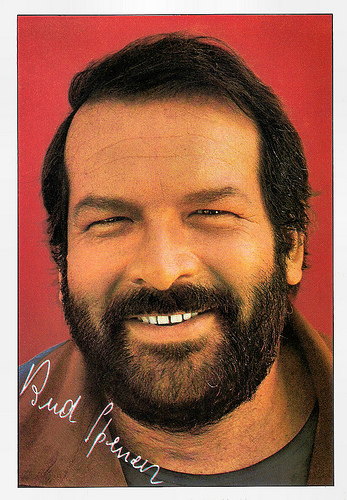
German autograph card by BRAVO.
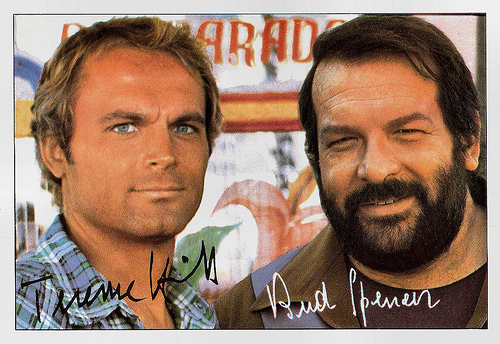
With Terence Hill . German autograph card by BRAVO.
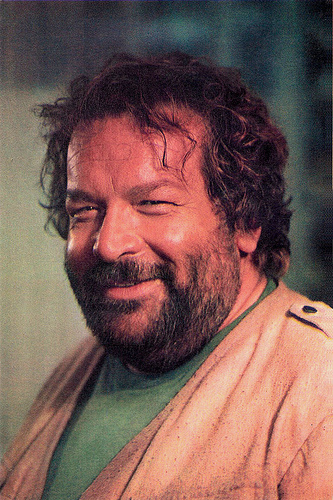
Italian postcard. Promotional card for Io Sto Con Gli Ippopotami/I'm for the Hippopotamus (Italo Zingarelli, 1979).
Bitten By the Acting Bug
Bud Spencer was born Carlo Pedersoli in Santa Lucia, a historical part of the city of Naples, in 1929. He was educated as an attorney and he even got a Juris Doctor degree, but Carlo was bitten by the acting bug.
His first film role was as a member of the Praetorian guard in the MGM epic Quo Vadis (Mervyn Leroy, 1951), shot in Italy. During the 1950s, he appeared in minor parts in various films made for the Italian market. Italian director Mario Monicelli gave him his first big role in Un eroe dei nostri tempi/A Hero of Our Times (Mario Monicelli, 1955) with Alberto Sordi .
Pedersoli was also a successful swimmer. In 1950, he was the first Italian to swim the 100 m freestyle in less than one minute (59.5 seconds). In the 1951 Mediterranean Games, he won a silver medal in the same 100 m freestyle event.
He participated in the 1952 Olympic Games in Helsinki, Finland, reaching the semi-finals in the 100 m freestyle (58.8 s heats, 58.9 s semi final). Four years later, in Melbourne, he also entered the semi-finals in the same category (58.5 s heat, 59.0 s semi final). As a water polo player, he won the Italian Championship in 1954, with S.S. Lazio. His swimming career ended abruptly in 1957.
Pedersoli appeared in some more Italian films such as the Peplum Annibale/Hannibal (Carlo Ludovico Bragaglia, Edgar G. Ulmer, 1959) starring Victor Mature, but for most of the 1960s his film career would stay minor league.
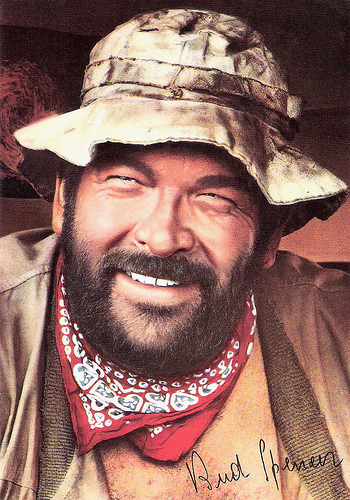
Italian postcard by Alterocca, Ferni.
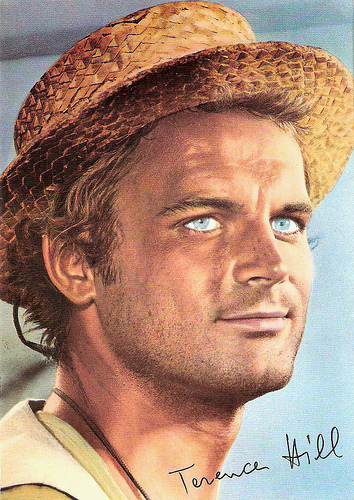
Terence Hill . Italian postcard by Alterocca, Ferni.
God Forgives... I Don't!
In 1967 Carlo Pedersoli changed his screen name to Bud Spencer. Reportedly he chose this pseudonym to pay homage to Hollywood star Spencer Tracy as well as to his favourite Czech-American beer, Budweiser. Other sources report that he found it funny to call himself ‘Bud’ despite his weight and his height at 1.94 m, which made him beloved as 'the big friendly giant' of the screen.
With Terence Hill a.k.a. Mario Girotti , he appeared in the Spaghetti Western Dio perdona... Io no!/God Forgives... I Don't! (Giuseppe Colizzi, 1967). Their pairing was a coincidence while a foot injury had forced lead actor Peter Martell (Pietro Martellanza) off the picture. Terence Hill took over the part of the pistolero Cat Stevens, and the rest is history.
Their dual outings made both actors famous, particularly in Europe. At IMDb , reviewer Benjamin Gauss calls Dio perdona... Io no!/God Forgives... I Don't! one of their best films: “Although the movie has many gags and humorous parts, God Forgives... I Don't! is not one of the usual Spencer/Hill comedies, but a pretty brutal and rather serious Spaghetti Western”.
Dio perdona... Io no!/God Forgives... I Don't! wasn’t their first film together. Both had also appeared in the Peplum Annibale/Hannibal (1959). After the success of Dio perdona... Io no! followed such Westerns as I quattro dell'Ave Maria/Ace High (Giuseppe Colizzi, 1967) with Eli Wallach, and La collina degli stivali/Boot Hill (Giuseppe Colizzi, 1969) with Woody Strode.
Then they played two brothers in Lo chiamavano Trinità.../They Call Me Trinity (Enzo Barboni a.k.a. E.B. Clucher, 1970), a comedic spoof of the Spaghetti Western genre. They Call Me Trinity became Italy’s top-grossing title.The enormous success lead to the sequel ...continuavano a chiamarlo Trinità/Trinity Is STILL My Name! (Enzo Barboni, 1971) with Harry Carey Jr., which became an even bigger success.
Most of these films have alternate titles, depending upon the country and distributor. Some films have longer Italian versions that were edited for release abroad. Hill and Spencer also appeared together in other action genres, such as in the pirate adventure Il corsaro nero/Blackie the Pirate (Lorenzo Gicca Palli, 1971), the action film ...Altrimenti ci arrabbiamo!/Watch Out, We're Mad (Marcello Fondato, 1974) with Donald Pleasence, and another actioner I due superpiedi quasi piatti/Crime Busters (Enzo Barboni, 1977).
Practically all of Bud Spencer's films have him playing the role of a bearded, balding, and brawny omnipotent who usually ends a fist fight by striking a hammer-like blow on the top of his opponent's head.
Romanian postcard by Casa Filmului Acin. Photo: publicity still for Continuavano a chiamarlo Trinità/Trinity is still my name (Enzo Barboni a.k.a. E.B. Clucher, 1971) with Terence Hill .
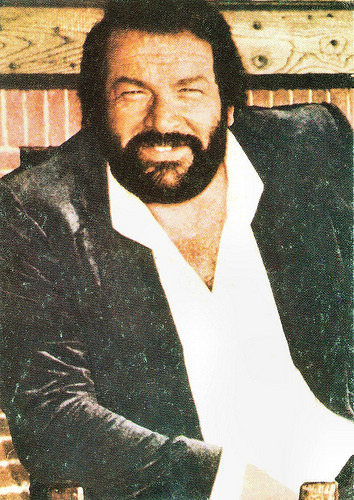
Romanian postcard by Casa Filmului Acin, no. 53189.
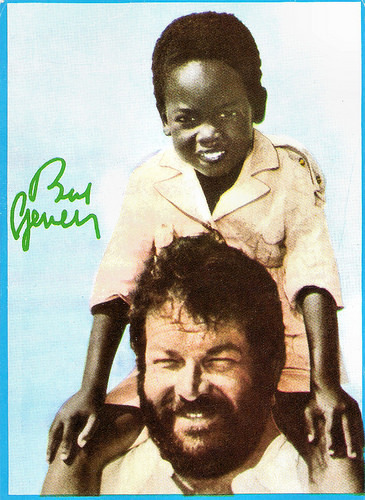
Romanian postcard by Casa Filmului Acin, no. 43 157. Photo: publicity still for Piedone l'africano/The knock-out cop (Steno, 1978) with Baldwin Dakile.
Extralarge
Bud Spencer also appeared solo in many films. He played in the Spaghetti Westerns Oggi a me... domani a te!/Today It's Me (Tonino Cervi, 1968) starring Brett Halsey aka Montgomery Ford, and Un esercito di cinque uomini/The Five Man Army (Don Taylor, Italo Zingarelli, 1969) with Peter Graves.
Spenver made a rare entry in the horror genre in 4 mosche di velluto grigio/4 Flies on Grey Velvet (Dario Argento, 1971) with Mimsy Farmer. Then he played a dramatic role as a man innocently kept in prison in Torino nera/Black Turin (Carlo Lizzani, 1972) with Françoise Fabian as his wife.
Later films include the action-packed potboilers Piedone lo sbirro/Piedone, the cop (Steno, 1973), and Lo chiamavano Bulldozer/They Call Him Bulldozer (Michele Lupo, 1978) with Raimund Harmstorf . Spencer also wrote the complete or partial screenplay for some of his films.
His feature film career slowed down after 1983, shifting more toward television. He also became a jet airplane and helicopter pilot in 1972. He established Mistral Air in 1984, an air-mail company that also transported pilgrims. He later sold it to Poste Italiane to buy a textile mill that produced clothes for children. He also has registered several patents.
In the 1990s he acted on TV in the comic action series Extralarge (Enzo G. Castellari, 1990-1993) and Noi siamo angeli/We Are Angels (Ruggero Deodato, 1997), both with Philip Michael Thomas, best known from the 1980s TV hit Miami Vice. His final film with Terence Hill was Botte di Natale/Troublemakers (Terence Hill, 1994).
After he made a film with internationally renowned Italian director Ermanno Olmi, Cantando dietro i paraventi/Singing Behind Screens (2003), Spencer confessed that was perhaps the first time he felt he was an actor. “I always said that I was only a character” as opposed to an actor, he said. The adventure-drama is loosely inspired to real life events of Chinese pirate Ching Shih. The film won three David di Donatello and four Nastro d'Argento Awards.
In 2005, Pedersoli briefly entered politics. Then-Prime Minister Silvio Berlusconi asked him to run as a regional councilor in Lazio for the centre-right Forza Italia party, but he was not elected. That same year he was awarded with the Caimano d'oro (Gold Caiman) by the Italian Swimming Federation. Two years later, he received swim and water polo coach diplomas from the Italian Swimming Federation's president Paolo Barelli.
Bud Spencer continued to appear on TV, and could be seen in the Italian Giallo-comedy television series I delitti del cuoco/Recipe for Crime (Alessandro Capone, 2010) and in an episode of the American comedy series Ninja the Mission Force (2013).
Since 1960, Carlo Pedersoli was married to Maria Amato. They had three children: Giuseppe (1961), Christine (1962) and Diamante (1972).
Pedersoli passed away “peacefully” in Rome on 27 June 2016, his son Giuseppe said in a media statement. Spencer said sports taught him humility. “One day you wake up and someone goes better than you. And you’re not anyone anymore. It’s the same way in cinema.”
Trailer of I quattro dell'Ave Maria/Ace High (1968). Source: Bud Spencer Official (YouTube).
Trailer of ...continuavano a chiamarlo Trinità/Trinity Is STILL My Name! (1971). Source: spencerhilltrailer (YouTube).
Trailer for Pari e dispari/Odds and Evens (1978). Source: Bud Spencer Official (YouTube).
Trailer for Non c'è due senza quattro/Double Trouble (1984). Source: spencerhilltrailer (YouTube).
Sources: (IMDb), Sandra Brennan (AllMovie), Nick Vivarelli (Variety), The Washington Times, Wikipedia, and .
On 27 June, 86-years old Bud Spencer has died in Rome, Italy of natural causes. The huge Italian actor with his trademark black beard was the popular star of many Spaghetti Westerns and low-budget action films of the late 1960s and 1970s. In 18 films he co-starred with his long time film partner Terence Hill. In his youth, Spencer (then: Carlo Pedersoli) was the first Italian to swim 100 metres in less than a minute. He also had a degree in law, and he registered several patents.

German autograph card by BRAVO.

With Terence Hill . German autograph card by BRAVO.

Italian postcard. Promotional card for Io Sto Con Gli Ippopotami/I'm for the Hippopotamus (Italo Zingarelli, 1979).
Bitten By the Acting Bug
Bud Spencer was born Carlo Pedersoli in Santa Lucia, a historical part of the city of Naples, in 1929. He was educated as an attorney and he even got a Juris Doctor degree, but Carlo was bitten by the acting bug.
His first film role was as a member of the Praetorian guard in the MGM epic Quo Vadis (Mervyn Leroy, 1951), shot in Italy. During the 1950s, he appeared in minor parts in various films made for the Italian market. Italian director Mario Monicelli gave him his first big role in Un eroe dei nostri tempi/A Hero of Our Times (Mario Monicelli, 1955) with Alberto Sordi .
Pedersoli was also a successful swimmer. In 1950, he was the first Italian to swim the 100 m freestyle in less than one minute (59.5 seconds). In the 1951 Mediterranean Games, he won a silver medal in the same 100 m freestyle event.
He participated in the 1952 Olympic Games in Helsinki, Finland, reaching the semi-finals in the 100 m freestyle (58.8 s heats, 58.9 s semi final). Four years later, in Melbourne, he also entered the semi-finals in the same category (58.5 s heat, 59.0 s semi final). As a water polo player, he won the Italian Championship in 1954, with S.S. Lazio. His swimming career ended abruptly in 1957.
Pedersoli appeared in some more Italian films such as the Peplum Annibale/Hannibal (Carlo Ludovico Bragaglia, Edgar G. Ulmer, 1959) starring Victor Mature, but for most of the 1960s his film career would stay minor league.

Italian postcard by Alterocca, Ferni.

Terence Hill . Italian postcard by Alterocca, Ferni.
God Forgives... I Don't!
In 1967 Carlo Pedersoli changed his screen name to Bud Spencer. Reportedly he chose this pseudonym to pay homage to Hollywood star Spencer Tracy as well as to his favourite Czech-American beer, Budweiser. Other sources report that he found it funny to call himself ‘Bud’ despite his weight and his height at 1.94 m, which made him beloved as 'the big friendly giant' of the screen.
With Terence Hill a.k.a. Mario Girotti , he appeared in the Spaghetti Western Dio perdona... Io no!/God Forgives... I Don't! (Giuseppe Colizzi, 1967). Their pairing was a coincidence while a foot injury had forced lead actor Peter Martell (Pietro Martellanza) off the picture. Terence Hill took over the part of the pistolero Cat Stevens, and the rest is history.
Their dual outings made both actors famous, particularly in Europe. At IMDb , reviewer Benjamin Gauss calls Dio perdona... Io no!/God Forgives... I Don't! one of their best films: “Although the movie has many gags and humorous parts, God Forgives... I Don't! is not one of the usual Spencer/Hill comedies, but a pretty brutal and rather serious Spaghetti Western”.
Dio perdona... Io no!/God Forgives... I Don't! wasn’t their first film together. Both had also appeared in the Peplum Annibale/Hannibal (1959). After the success of Dio perdona... Io no! followed such Westerns as I quattro dell'Ave Maria/Ace High (Giuseppe Colizzi, 1967) with Eli Wallach, and La collina degli stivali/Boot Hill (Giuseppe Colizzi, 1969) with Woody Strode.
Then they played two brothers in Lo chiamavano Trinità.../They Call Me Trinity (Enzo Barboni a.k.a. E.B. Clucher, 1970), a comedic spoof of the Spaghetti Western genre. They Call Me Trinity became Italy’s top-grossing title.The enormous success lead to the sequel ...continuavano a chiamarlo Trinità/Trinity Is STILL My Name! (Enzo Barboni, 1971) with Harry Carey Jr., which became an even bigger success.
Most of these films have alternate titles, depending upon the country and distributor. Some films have longer Italian versions that were edited for release abroad. Hill and Spencer also appeared together in other action genres, such as in the pirate adventure Il corsaro nero/Blackie the Pirate (Lorenzo Gicca Palli, 1971), the action film ...Altrimenti ci arrabbiamo!/Watch Out, We're Mad (Marcello Fondato, 1974) with Donald Pleasence, and another actioner I due superpiedi quasi piatti/Crime Busters (Enzo Barboni, 1977).
Practically all of Bud Spencer's films have him playing the role of a bearded, balding, and brawny omnipotent who usually ends a fist fight by striking a hammer-like blow on the top of his opponent's head.
Romanian postcard by Casa Filmului Acin. Photo: publicity still for Continuavano a chiamarlo Trinità/Trinity is still my name (Enzo Barboni a.k.a. E.B. Clucher, 1971) with Terence Hill .

Romanian postcard by Casa Filmului Acin, no. 53189.

Romanian postcard by Casa Filmului Acin, no. 43 157. Photo: publicity still for Piedone l'africano/The knock-out cop (Steno, 1978) with Baldwin Dakile.
Extralarge
Bud Spencer also appeared solo in many films. He played in the Spaghetti Westerns Oggi a me... domani a te!/Today It's Me (Tonino Cervi, 1968) starring Brett Halsey aka Montgomery Ford, and Un esercito di cinque uomini/The Five Man Army (Don Taylor, Italo Zingarelli, 1969) with Peter Graves.
Spenver made a rare entry in the horror genre in 4 mosche di velluto grigio/4 Flies on Grey Velvet (Dario Argento, 1971) with Mimsy Farmer. Then he played a dramatic role as a man innocently kept in prison in Torino nera/Black Turin (Carlo Lizzani, 1972) with Françoise Fabian as his wife.
Later films include the action-packed potboilers Piedone lo sbirro/Piedone, the cop (Steno, 1973), and Lo chiamavano Bulldozer/They Call Him Bulldozer (Michele Lupo, 1978) with Raimund Harmstorf . Spencer also wrote the complete or partial screenplay for some of his films.
His feature film career slowed down after 1983, shifting more toward television. He also became a jet airplane and helicopter pilot in 1972. He established Mistral Air in 1984, an air-mail company that also transported pilgrims. He later sold it to Poste Italiane to buy a textile mill that produced clothes for children. He also has registered several patents.
In the 1990s he acted on TV in the comic action series Extralarge (Enzo G. Castellari, 1990-1993) and Noi siamo angeli/We Are Angels (Ruggero Deodato, 1997), both with Philip Michael Thomas, best known from the 1980s TV hit Miami Vice. His final film with Terence Hill was Botte di Natale/Troublemakers (Terence Hill, 1994).
After he made a film with internationally renowned Italian director Ermanno Olmi, Cantando dietro i paraventi/Singing Behind Screens (2003), Spencer confessed that was perhaps the first time he felt he was an actor. “I always said that I was only a character” as opposed to an actor, he said. The adventure-drama is loosely inspired to real life events of Chinese pirate Ching Shih. The film won three David di Donatello and four Nastro d'Argento Awards.
In 2005, Pedersoli briefly entered politics. Then-Prime Minister Silvio Berlusconi asked him to run as a regional councilor in Lazio for the centre-right Forza Italia party, but he was not elected. That same year he was awarded with the Caimano d'oro (Gold Caiman) by the Italian Swimming Federation. Two years later, he received swim and water polo coach diplomas from the Italian Swimming Federation's president Paolo Barelli.
Bud Spencer continued to appear on TV, and could be seen in the Italian Giallo-comedy television series I delitti del cuoco/Recipe for Crime (Alessandro Capone, 2010) and in an episode of the American comedy series Ninja the Mission Force (2013).
Since 1960, Carlo Pedersoli was married to Maria Amato. They had three children: Giuseppe (1961), Christine (1962) and Diamante (1972).
Pedersoli passed away “peacefully” in Rome on 27 June 2016, his son Giuseppe said in a media statement. Spencer said sports taught him humility. “One day you wake up and someone goes better than you. And you’re not anyone anymore. It’s the same way in cinema.”
Trailer of I quattro dell'Ave Maria/Ace High (1968). Source: Bud Spencer Official (YouTube).
Trailer of ...continuavano a chiamarlo Trinità/Trinity Is STILL My Name! (1971). Source: spencerhilltrailer (YouTube).
Trailer for Pari e dispari/Odds and Evens (1978). Source: Bud Spencer Official (YouTube).
Trailer for Non c'è due senza quattro/Double Trouble (1984). Source: spencerhilltrailer (YouTube).
Sources: (IMDb), Sandra Brennan (AllMovie), Nick Vivarelli (Variety), The Washington Times, Wikipedia, and .
Published on August 13, 2018 22:00
August 12, 2018
5 million pageviews for EFSP - Claudia Cardinale
On 11 August 2018, the pageview teller of European Film Star Postcards passed the 5,000,000. We commemorate this milestone with updates of our five most popular posts of all times. Today number 4, the first part of a double post on Claudia Cardinale. It was last updated on 16 November 2015 and counted 9822 page views. Click here for Part 2.
Italian actress Claudia Cardinale (1938) is one of Europe's iconic and most versatile film stars. The combination of her beauty, dark, flashing eyes, explosive sexuality and genuine acting talent virtually guaranteed her stardom. Her most notable films include the classics 8½ (Federico Fellini, 1963), Il Gattopardo (Luchino Visconti, 1963), and Once Upon a Time in the West (Sergio Leone, 1968).
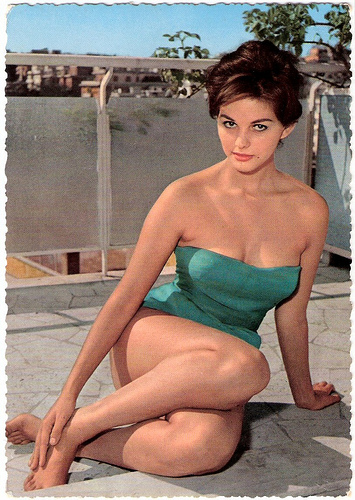
German postcard by Krüger, no. 902/164. Photo: Georg Michalke / UFA.
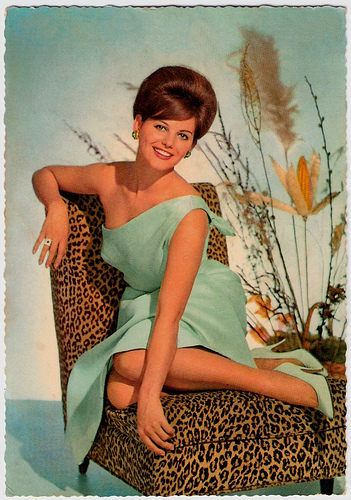
German postcard by Krüger, no. 902/132. Photo: Sam Levin / Ufa.
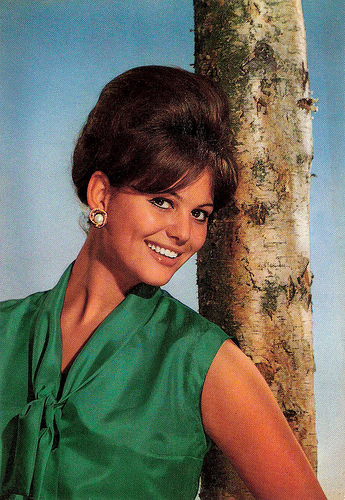
French postcard by E.D.U.G., no. 243, offered by Les Carbones Korès Carboplane. Photo: Sam Lévin.
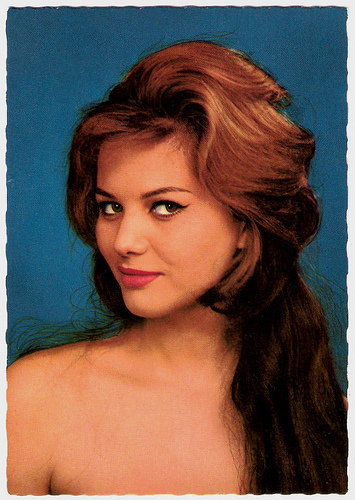
German postcard by Filmbilder-Vertrieb Ernst Freihoff, Essen, no. H 72.
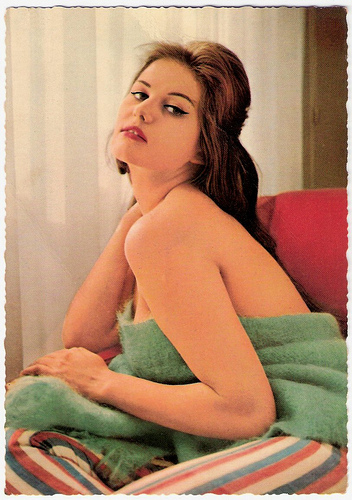
German postcard by Krüger, no. 902/115.
The most beautiful Italian girl in Tunisia
Claude Joséphine Rose Cardinale was born in La Goulette in Tunisia in 1938 (some sources claim 1939). Her mother, Yolande Greco, was born in Tunisia to Italian (Sicilian) emigrants from Trapani, Italy. Her father was an Italian (Sicilian) railway worker, born in Gela, Italy.
Her native languages were Tunisian Arabic and French. She received a French education and she had to learn Italian once she pursued her acting career.
She had her break in films after she was voted the most beautiful Italian girl in Tunisia in 1957. The contest of the Italian embassy had as a prize a trip to the Venice Film Festival. She made her film debut in the French-Tunisian coproduction Goha (Jacques Baratier, 1958) starring Omar Sharif.
After attending the Centro Sperimentale di Cinematografia in Rome for two months, she signed a 7-year contract with the Vides studios. The contract forbade her to cut her hair, to marry or to gain weight.
Later that year she had a role in the heist comedy I soliti ignoti/Big Deal On Madonna Street (Mario Monicelli, 1958) with Vittorio Gassman and Renato Salvatori . The film was an international success, and her film career was off and running.
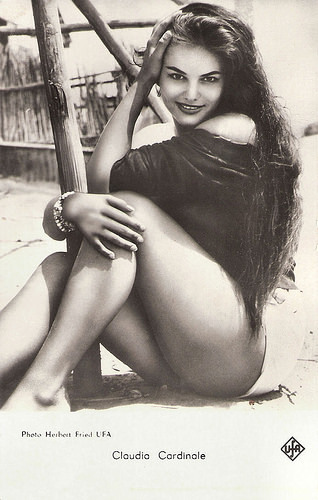
French postcard by Editions P.I., no. FK 104. Photo: Herbert Fried / Ufa.
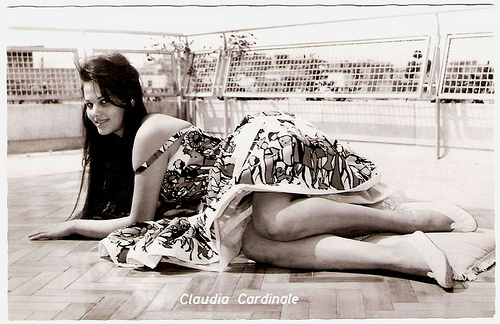
German postcard by Kolibri (W. Sander Verlag, Minden), no. 1865.
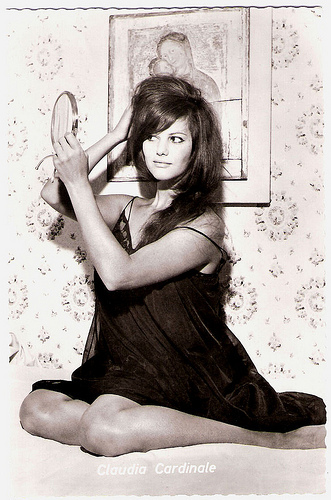
German postcard by Kolibri (W. Sander Verlag, Minden), no. 1968.
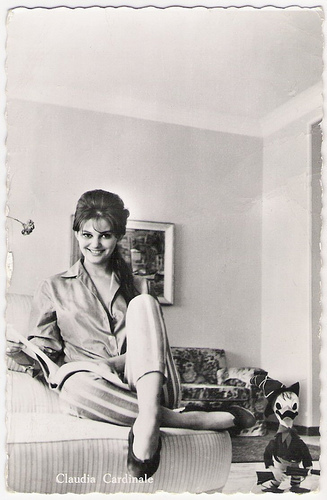
Dutch postcard.
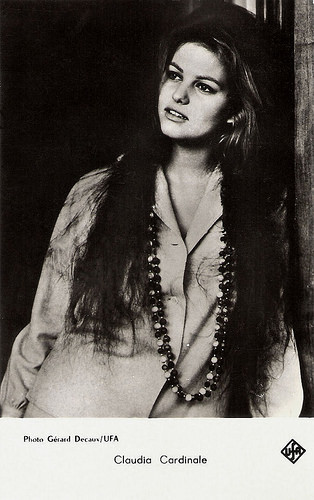
French postcard by Editions P.I., Paris, French licency holder for Ufa, presented by Les Carbones Korès 'Carboplane', no. FK 99 B Photo: Gérard Décaux / Ufa.
After BB Comes CC
At this point, the press, noting her initials, announced that CC was the natural successor to BB ( Brigitte Bardot ), and began beating the drum on her behalf.
Dozens of alluring photographs of Claudia Cardinale were displayed in newspapers and magazines throughout the world. According to IMDb , she has appeared on more than 900 magazine covers in over 25 countries.
The contrast between these pictures and those of Marilyn Monroe or Jayne Mansfield is striking. Cardinale never appeared in a nude or fully topless scene. Her pictures promoted an image of a shy family girl who just happened to have a beautiful face and a sexy body.
A photograph of Cardinale was featured in the original gate fold artwork to Bob Dylan's album Blonde on Blonde (1966), but because it was used without Cardinale's permission, the photo was removed from the cover art in later pressings.
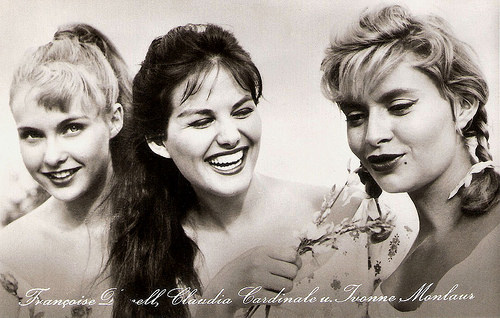
East-German postcard by VEB Progress Filmvertrieb, no. 1187, 1960. Publicity still for Tre straniere a Roma/Three Strangers in Rome (Claudio Gora, 1958) with Yvonne Monlaur and Francoise Darnell.
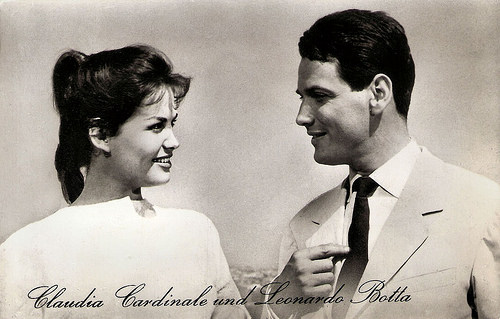
East-German postcard by VEB Progress Filmvertrieb. Publicity still for Tre straniere a Roma/Three Strangers in Rome (Claudio Gora, 1958) with Leonardo Botta.
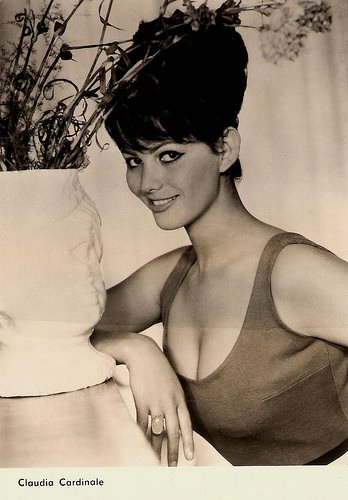
East-German postcard by VEB Progress Filmvertrieb, Berlin, no. 2569, 1965.
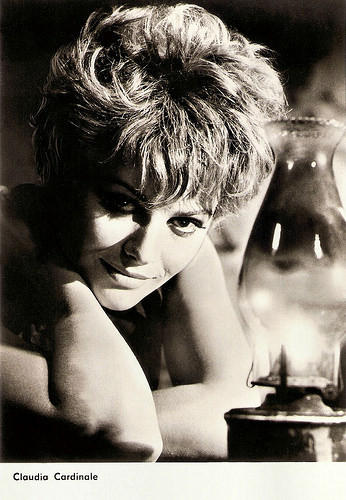
East-German postcard by VEB Progress Filmvertrieb, Berlin, no. 2388, 1965.
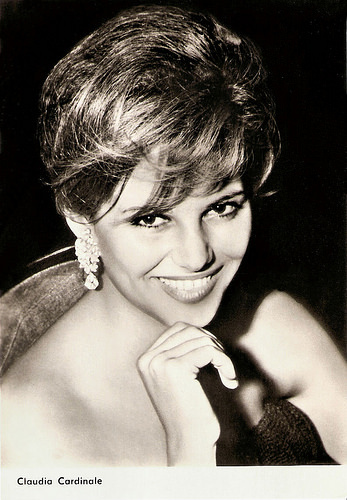
East-German postcard by VEB Progress Filmvertrieb, Berlin, no. 2268, 1965.
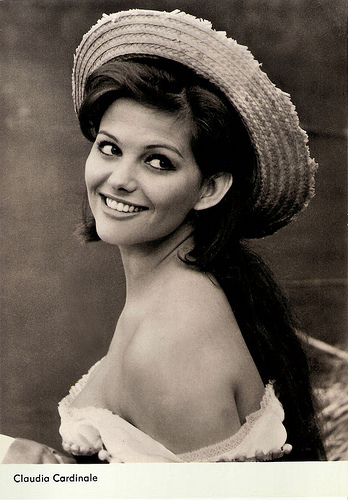
East-German postcard by VEB Progress Filmvertrieb, Berlin, no. 2949, 1967.
Manager-Producer-Husband
Claudia Cardinale's early career was largely managed producer Franco Cristaldi. Because of her film contract, she told everyone that her son Patrizio was her baby brother. He was born out of wedlock when she was 17; the father was a mysterious Frenchman. She did not reveal to the child that he was her son until he was 19 years old. In 1966, she married Cristaldi, who adopted Patrizio.
In only three years she made a stream of great films. First she made three successful comedies, Un Maledetto imbroglio/The Facts of Murder (Pietro Germi, 1959), Il Bell'Antonio/Bell'Antonio (Mauro Bolognini, 1960) featuring Marcello Mastroianni , and Audace colpo dei soliti ignoti/Fiasco in Milan (Nanni Loy, 1960).
Cardinale had a supporting part in the epic drama Rocco e i suoi fratelli/Rocco and His Brothers (Luchino Visconti, 1960) in which she played the sister-in-law of Alain Delon and Renato Salvatori.
And then followed leading parts in La Ragazza con la valigia/Girl with a Suitcase (Valerio Zurlini, 1961), La Viaccia/The Lovemakers (Mauro Bolognini, 1961) with Jean-Paul Belmondo , and Senilità/Careless (Mauro Bolognini, 1961).
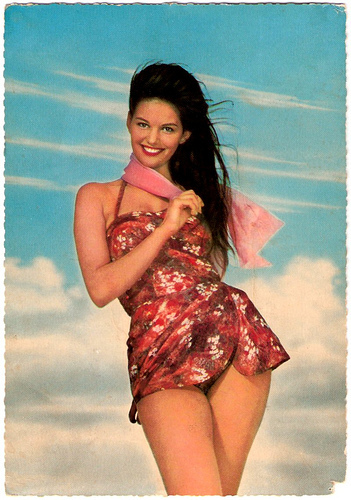
German postcard by Krüger.
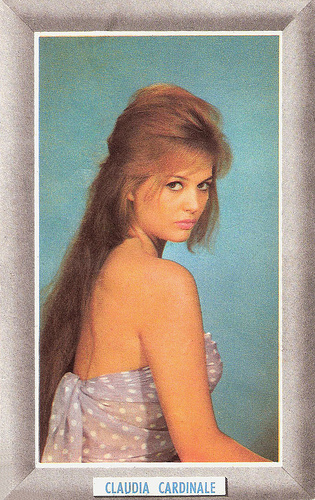
French postcard.
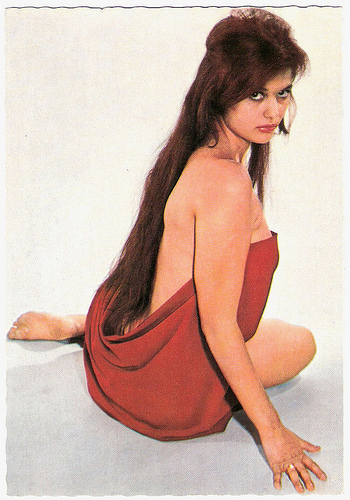
German postcard by ISV, Sort. 10/6.
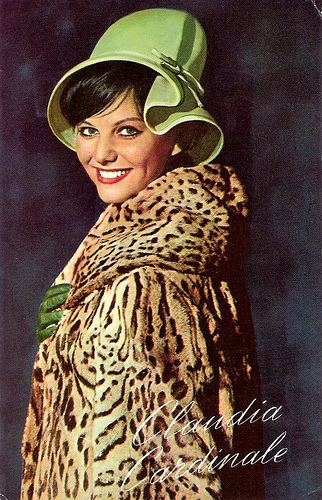
Dutch postcard, Serie 6.
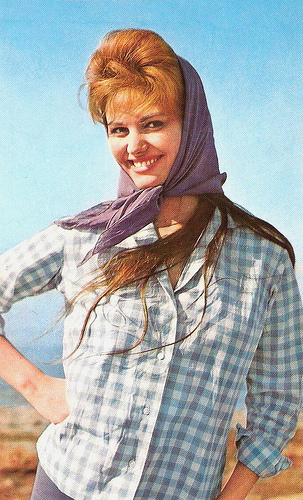
French postcard by Editions P.I., Paris, no. 1084, offered by Corvisart, Epinal. Photo: Ektachrome Anders.
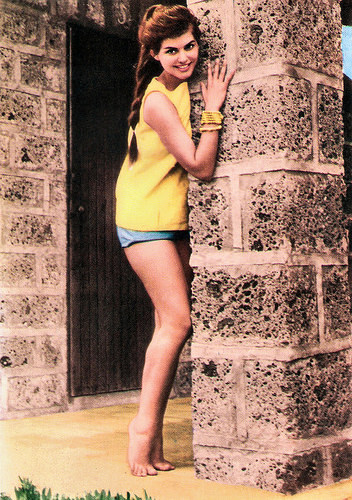
Spanish postcard by Postal Oscar Color, Hospitalet (Barcelona), no. 521, 1963.
Deep voice and heavy accent
Claudia Cardinale had a deep, sultry voice and spoke Italian with a heavy French accent, so her voice was dubbed in her early films.
In Federico Fellini's 8½ (1963), she was finally allowed to dub her own dialogue. In the film, she plays a dream woman - a character named Claudia, who is the object of the fantasies of the director in the film, played by Marcello Mastroianni . With Fellini's surrealistic masterpiece she received her widest exposure to date with this film.
That same year, she also appeared in another masterpiece of the Italian cinema, the epic Il Gattopardo/The Leopard (Luchino Visconti, 1963) with Burt Lancaster and Alain Delon .
The combined success of these two classic films made her rise to the front ranks of the Italian cinema. And it also piqued Hollywood's interest.
To be continued tomorrow.
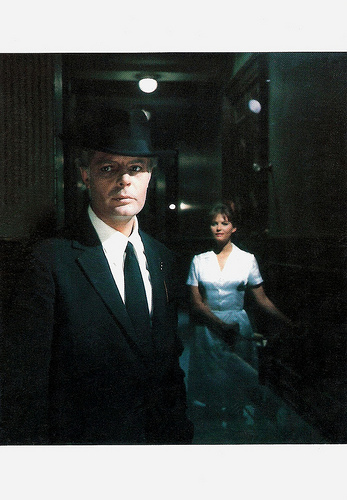
French postcard by Edition La Malibran, Paris, no. MC 38, 1990. Photo: Claude Schwartz. Publicity still for Otto e Mezzo/8½ (Federico Fellini, 1963) with Marcello Mastroianni .
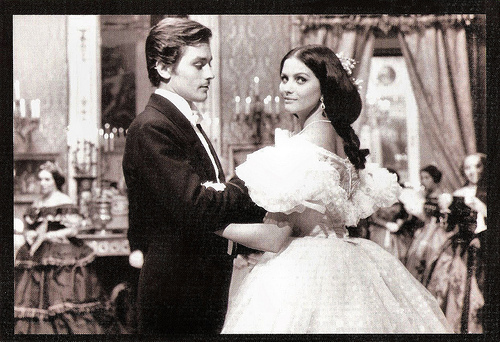
Vintage card. Photo: publicity still for Il Gattopardo/The Leopard (Luchino Visconti, 1963) with Alain Delon .
Original Italian trailer of 8½ (1963). Source: Raúl Quintanilla (YouTube).
Original Italian trailer of Il Gattopardo/The Leopard (1963). Source: Blondinka Inoz (YouTube).
Sources: Jason Ankeny (AllMovie), Roger Fristoe (TCM), and Wikipedia.
Italian actress Claudia Cardinale (1938) is one of Europe's iconic and most versatile film stars. The combination of her beauty, dark, flashing eyes, explosive sexuality and genuine acting talent virtually guaranteed her stardom. Her most notable films include the classics 8½ (Federico Fellini, 1963), Il Gattopardo (Luchino Visconti, 1963), and Once Upon a Time in the West (Sergio Leone, 1968).

German postcard by Krüger, no. 902/164. Photo: Georg Michalke / UFA.

German postcard by Krüger, no. 902/132. Photo: Sam Levin / Ufa.

French postcard by E.D.U.G., no. 243, offered by Les Carbones Korès Carboplane. Photo: Sam Lévin.

German postcard by Filmbilder-Vertrieb Ernst Freihoff, Essen, no. H 72.

German postcard by Krüger, no. 902/115.
The most beautiful Italian girl in Tunisia
Claude Joséphine Rose Cardinale was born in La Goulette in Tunisia in 1938 (some sources claim 1939). Her mother, Yolande Greco, was born in Tunisia to Italian (Sicilian) emigrants from Trapani, Italy. Her father was an Italian (Sicilian) railway worker, born in Gela, Italy.
Her native languages were Tunisian Arabic and French. She received a French education and she had to learn Italian once she pursued her acting career.
She had her break in films after she was voted the most beautiful Italian girl in Tunisia in 1957. The contest of the Italian embassy had as a prize a trip to the Venice Film Festival. She made her film debut in the French-Tunisian coproduction Goha (Jacques Baratier, 1958) starring Omar Sharif.
After attending the Centro Sperimentale di Cinematografia in Rome for two months, she signed a 7-year contract with the Vides studios. The contract forbade her to cut her hair, to marry or to gain weight.
Later that year she had a role in the heist comedy I soliti ignoti/Big Deal On Madonna Street (Mario Monicelli, 1958) with Vittorio Gassman and Renato Salvatori . The film was an international success, and her film career was off and running.

French postcard by Editions P.I., no. FK 104. Photo: Herbert Fried / Ufa.

German postcard by Kolibri (W. Sander Verlag, Minden), no. 1865.

German postcard by Kolibri (W. Sander Verlag, Minden), no. 1968.

Dutch postcard.

French postcard by Editions P.I., Paris, French licency holder for Ufa, presented by Les Carbones Korès 'Carboplane', no. FK 99 B Photo: Gérard Décaux / Ufa.
After BB Comes CC
At this point, the press, noting her initials, announced that CC was the natural successor to BB ( Brigitte Bardot ), and began beating the drum on her behalf.
Dozens of alluring photographs of Claudia Cardinale were displayed in newspapers and magazines throughout the world. According to IMDb , she has appeared on more than 900 magazine covers in over 25 countries.
The contrast between these pictures and those of Marilyn Monroe or Jayne Mansfield is striking. Cardinale never appeared in a nude or fully topless scene. Her pictures promoted an image of a shy family girl who just happened to have a beautiful face and a sexy body.
A photograph of Cardinale was featured in the original gate fold artwork to Bob Dylan's album Blonde on Blonde (1966), but because it was used without Cardinale's permission, the photo was removed from the cover art in later pressings.

East-German postcard by VEB Progress Filmvertrieb, no. 1187, 1960. Publicity still for Tre straniere a Roma/Three Strangers in Rome (Claudio Gora, 1958) with Yvonne Monlaur and Francoise Darnell.

East-German postcard by VEB Progress Filmvertrieb. Publicity still for Tre straniere a Roma/Three Strangers in Rome (Claudio Gora, 1958) with Leonardo Botta.

East-German postcard by VEB Progress Filmvertrieb, Berlin, no. 2569, 1965.

East-German postcard by VEB Progress Filmvertrieb, Berlin, no. 2388, 1965.

East-German postcard by VEB Progress Filmvertrieb, Berlin, no. 2268, 1965.

East-German postcard by VEB Progress Filmvertrieb, Berlin, no. 2949, 1967.
Manager-Producer-Husband
Claudia Cardinale's early career was largely managed producer Franco Cristaldi. Because of her film contract, she told everyone that her son Patrizio was her baby brother. He was born out of wedlock when she was 17; the father was a mysterious Frenchman. She did not reveal to the child that he was her son until he was 19 years old. In 1966, she married Cristaldi, who adopted Patrizio.
In only three years she made a stream of great films. First she made three successful comedies, Un Maledetto imbroglio/The Facts of Murder (Pietro Germi, 1959), Il Bell'Antonio/Bell'Antonio (Mauro Bolognini, 1960) featuring Marcello Mastroianni , and Audace colpo dei soliti ignoti/Fiasco in Milan (Nanni Loy, 1960).
Cardinale had a supporting part in the epic drama Rocco e i suoi fratelli/Rocco and His Brothers (Luchino Visconti, 1960) in which she played the sister-in-law of Alain Delon and Renato Salvatori.
And then followed leading parts in La Ragazza con la valigia/Girl with a Suitcase (Valerio Zurlini, 1961), La Viaccia/The Lovemakers (Mauro Bolognini, 1961) with Jean-Paul Belmondo , and Senilità/Careless (Mauro Bolognini, 1961).

German postcard by Krüger.

French postcard.

German postcard by ISV, Sort. 10/6.

Dutch postcard, Serie 6.

French postcard by Editions P.I., Paris, no. 1084, offered by Corvisart, Epinal. Photo: Ektachrome Anders.

Spanish postcard by Postal Oscar Color, Hospitalet (Barcelona), no. 521, 1963.
Deep voice and heavy accent
Claudia Cardinale had a deep, sultry voice and spoke Italian with a heavy French accent, so her voice was dubbed in her early films.
In Federico Fellini's 8½ (1963), she was finally allowed to dub her own dialogue. In the film, she plays a dream woman - a character named Claudia, who is the object of the fantasies of the director in the film, played by Marcello Mastroianni . With Fellini's surrealistic masterpiece she received her widest exposure to date with this film.
That same year, she also appeared in another masterpiece of the Italian cinema, the epic Il Gattopardo/The Leopard (Luchino Visconti, 1963) with Burt Lancaster and Alain Delon .
The combined success of these two classic films made her rise to the front ranks of the Italian cinema. And it also piqued Hollywood's interest.
To be continued tomorrow.

French postcard by Edition La Malibran, Paris, no. MC 38, 1990. Photo: Claude Schwartz. Publicity still for Otto e Mezzo/8½ (Federico Fellini, 1963) with Marcello Mastroianni .

Vintage card. Photo: publicity still for Il Gattopardo/The Leopard (Luchino Visconti, 1963) with Alain Delon .
Original Italian trailer of 8½ (1963). Source: Raúl Quintanilla (YouTube).
Original Italian trailer of Il Gattopardo/The Leopard (1963). Source: Blondinka Inoz (YouTube).
Sources: Jason Ankeny (AllMovie), Roger Fristoe (TCM), and Wikipedia.
Published on August 12, 2018 22:00
August 11, 2018
5 million pageviews for EFSP - Aïché Nana
Yesterday, 11 August 2018, the pageview teller of European Film Star Postcards passed the 5,000,000. In the upcoming days, we'll update our five most popular posts of all times to commemorate this milestone. We start with number 5: an I.M. for
Aïché Nana, which we posted at EFSP on 31 January 2014, two days after her death. This post had 8581 views, till now.
On 29 January, Lebanese actress and former belly dancer Aïché Nana (1940-2014) died. In 1958, a 'striptease' by the then 18 years old Nana at a Roman party caused an international scandal. Subsequently she became one of the icons of ‘La Dolce Vita’, the liberated era of sex, drugs and rock & roll as documented by Federico Fellini. Aïché Nana appeared in 15 European films between 1956 and 1985.
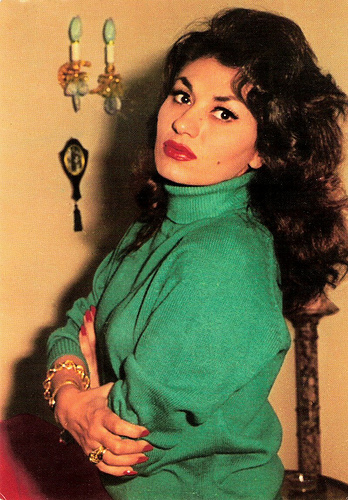
Italian postcard by Rotalcolor, Milano (Milan), no. 238.
High-powered Publicity
Aïché Nana was born as Kiash Nanah in Beirut, Lebanon, in 1940.
She became a famous belly-dancer in Istanbul and soon also danced in Paris left-bank cabarets. She reportedly employed high-powered publicity to sell her act to European producers. In 1956 French newspapers reported her mysterious disappearance from a Paris cabaret after writing a single word on a paper in her dressing room: "Farewell”. After the French police was alerted and in the midst of all the publicity, she suddenly returned in good shape.
In 1958, the then 18 year old dancer caused a scandal that alerted the world to the luxurious and decadent lifestyle of the international jet-set in Rome that soon would become known as La Dolce Vita. Thanks to Cinecittà, the film production studios on the east side of the city, Rome had become a popular location for Hollywood films, and the foreign stars and writers began hanging out in the bars of Via Veneto.
On that historical November night, the Swedish actress Anita Ekberg danced barefoot at a party in the Rugantino, a trattoria in Trastevere before Aïché Nana stripped to her knickers. The public was a mix of playboys, film stars like Linda Christian and Elsa Martinelli , and aristocrats, who fled when the police arrived. To the police Aïcha claimed that merrymakers had ripped off her clothes.
The next day the striptease became a historical scandal when gossip columnist Victor Ciuffa published photo’s taken by Tazio Secchiaroli in his column in the newspaper, Corriere d'Informazione. Years later, Ciuffa would claimn to be the subject for the Marcello Mastroianni character in La Dolce Vita/The Sweet Life (Federico Fellini, 1960))
The published photos gave lie to Aïché Nana’s story to the police. Italian authorities threatened her with a three year jail sentence and she quickly returned to Paris where striptease was permitted at the time.
The photos were published in magazines all over the world, including the famous American weekly Life. Later both Anita Ekberg's barefoot dance and Aïché Nana’s striptease were immortalised in La Dolce Vita/The Sweet Life (Federico Fellini, 1960). Tazio Secchiaroli, the original paparazzo, became the director’s privileged stills photographer.
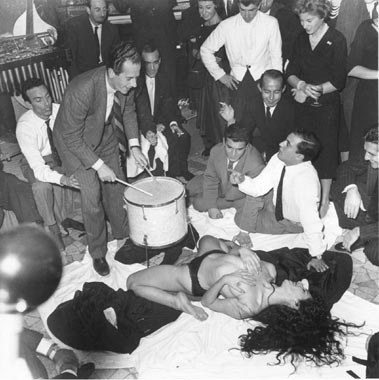
Aïché Nana’s striptease in Rugantino. Photos: Tazio Secchiaroli. Source: Iconic Photos.
Nunsploitation
Aïché Nana ad already appeared as a dancer in the French-Italian adventure film La châtelaine du Liban/The Lebanese Mission (Richard Pottier, 1956) starring Jean-Claude Pascal and Omar Sharif. Just 16, she stayed in Europe and danced ín the Frankie Howerd comedy A Touch of the Sun (Gordon Parry, 1956).
Following her moment of infamy, Nana became something of a celebrity. So, she stepped up to proper, secondary roles in the 1960s. The majority of her parts were in Euro-Westerns where her dark looks made her a natural at playing Mexicans. She appeared with bodybuilder Mickey Hargitay in the Spanish-Italian Western Lo sceriffo che non spara/The Sheriff Won’t Shoot (José Luis Monter, Renato Polselli, 1965).
Among her other Spaghetti Westerns were Thompson 1880 (Guido Zurli, 1966) with George Martin and Gordon Mitchell, Crisantemi per un branco di carogne/Chrysanthemums for a Bunch of Swine (Sergio Pastore, 1968) with Edmund Purdom , and Giurò... e li uccise ad uno ad uno/Gun Shy Piluk (Guido Celano, 1968) also starring Purdom as a coffin maker.
She also appeared in the thriller A... come assassin/A… Like Assassin (Angelo Dorigo, 1966) starring Alan Steel (aka the Italian actor Sergio Ciani) and was the leading lady of another Italian thriller Due occhi per uccidere/Two Eyes To Kill (Renato Borraccetti, 1968).
In the 1970s she appeared in Edipeon (Lorenzo Arato, 1970) with Magali Noël and Massimo Serato , the Oscar nominated comedy I nuovi mostri/The New Monsters (Mario Monicelli, Dino Risi, Ettore Scola, 1977) starring Vittorio Gassmann and Ornella Muti , and the Nunsploitation film Immagini di un convent/Images in a Convent (Joe D’Amato, 1979).
In the 1980s followed roles in two big budget productions. In Marco Ferreri’s Storia di Piera/The Story of Piera (1983) she supported a star cast including Isabelle Huppert , Hanna Schygulla and Marcello Mastroianni . Her final film was the British-American Bible epic King David (Bruce Beresford, 1985) starring Richard Gere as the King of Israel who took on Goliath.
Aïché Nana was married to director Sergio Pastore (1932-1987), who had directed her in Crisantemi per un branco di carogne
German trailer for Thompson 1880 (Guido Zurli, 1966). Don't glimpse or you'll miss Aïché. Source: The Spaghetti Western Database (YouTube).
Sources: La Repubblica (Italian), Corriere della Sera (Italian), Matt Blake (The Wild Eye), Tom Kington (The Observer), Benito Carlo Jr. (The Inside Story via Modern Mechanix Blog), Life and .
On 29 January, Lebanese actress and former belly dancer Aïché Nana (1940-2014) died. In 1958, a 'striptease' by the then 18 years old Nana at a Roman party caused an international scandal. Subsequently she became one of the icons of ‘La Dolce Vita’, the liberated era of sex, drugs and rock & roll as documented by Federico Fellini. Aïché Nana appeared in 15 European films between 1956 and 1985.

Italian postcard by Rotalcolor, Milano (Milan), no. 238.
High-powered Publicity
Aïché Nana was born as Kiash Nanah in Beirut, Lebanon, in 1940.
She became a famous belly-dancer in Istanbul and soon also danced in Paris left-bank cabarets. She reportedly employed high-powered publicity to sell her act to European producers. In 1956 French newspapers reported her mysterious disappearance from a Paris cabaret after writing a single word on a paper in her dressing room: "Farewell”. After the French police was alerted and in the midst of all the publicity, she suddenly returned in good shape.
In 1958, the then 18 year old dancer caused a scandal that alerted the world to the luxurious and decadent lifestyle of the international jet-set in Rome that soon would become known as La Dolce Vita. Thanks to Cinecittà, the film production studios on the east side of the city, Rome had become a popular location for Hollywood films, and the foreign stars and writers began hanging out in the bars of Via Veneto.
On that historical November night, the Swedish actress Anita Ekberg danced barefoot at a party in the Rugantino, a trattoria in Trastevere before Aïché Nana stripped to her knickers. The public was a mix of playboys, film stars like Linda Christian and Elsa Martinelli , and aristocrats, who fled when the police arrived. To the police Aïcha claimed that merrymakers had ripped off her clothes.
The next day the striptease became a historical scandal when gossip columnist Victor Ciuffa published photo’s taken by Tazio Secchiaroli in his column in the newspaper, Corriere d'Informazione. Years later, Ciuffa would claimn to be the subject for the Marcello Mastroianni character in La Dolce Vita/The Sweet Life (Federico Fellini, 1960))
The published photos gave lie to Aïché Nana’s story to the police. Italian authorities threatened her with a three year jail sentence and she quickly returned to Paris where striptease was permitted at the time.
The photos were published in magazines all over the world, including the famous American weekly Life. Later both Anita Ekberg's barefoot dance and Aïché Nana’s striptease were immortalised in La Dolce Vita/The Sweet Life (Federico Fellini, 1960). Tazio Secchiaroli, the original paparazzo, became the director’s privileged stills photographer.

Aïché Nana’s striptease in Rugantino. Photos: Tazio Secchiaroli. Source: Iconic Photos.
Nunsploitation
Aïché Nana ad already appeared as a dancer in the French-Italian adventure film La châtelaine du Liban/The Lebanese Mission (Richard Pottier, 1956) starring Jean-Claude Pascal and Omar Sharif. Just 16, she stayed in Europe and danced ín the Frankie Howerd comedy A Touch of the Sun (Gordon Parry, 1956).
Following her moment of infamy, Nana became something of a celebrity. So, she stepped up to proper, secondary roles in the 1960s. The majority of her parts were in Euro-Westerns where her dark looks made her a natural at playing Mexicans. She appeared with bodybuilder Mickey Hargitay in the Spanish-Italian Western Lo sceriffo che non spara/The Sheriff Won’t Shoot (José Luis Monter, Renato Polselli, 1965).
Among her other Spaghetti Westerns were Thompson 1880 (Guido Zurli, 1966) with George Martin and Gordon Mitchell, Crisantemi per un branco di carogne/Chrysanthemums for a Bunch of Swine (Sergio Pastore, 1968) with Edmund Purdom , and Giurò... e li uccise ad uno ad uno/Gun Shy Piluk (Guido Celano, 1968) also starring Purdom as a coffin maker.
She also appeared in the thriller A... come assassin/A… Like Assassin (Angelo Dorigo, 1966) starring Alan Steel (aka the Italian actor Sergio Ciani) and was the leading lady of another Italian thriller Due occhi per uccidere/Two Eyes To Kill (Renato Borraccetti, 1968).
In the 1970s she appeared in Edipeon (Lorenzo Arato, 1970) with Magali Noël and Massimo Serato , the Oscar nominated comedy I nuovi mostri/The New Monsters (Mario Monicelli, Dino Risi, Ettore Scola, 1977) starring Vittorio Gassmann and Ornella Muti , and the Nunsploitation film Immagini di un convent/Images in a Convent (Joe D’Amato, 1979).
In the 1980s followed roles in two big budget productions. In Marco Ferreri’s Storia di Piera/The Story of Piera (1983) she supported a star cast including Isabelle Huppert , Hanna Schygulla and Marcello Mastroianni . Her final film was the British-American Bible epic King David (Bruce Beresford, 1985) starring Richard Gere as the King of Israel who took on Goliath.
Aïché Nana was married to director Sergio Pastore (1932-1987), who had directed her in Crisantemi per un branco di carogne
German trailer for Thompson 1880 (Guido Zurli, 1966). Don't glimpse or you'll miss Aïché. Source: The Spaghetti Western Database (YouTube).
Sources: La Repubblica (Italian), Corriere della Sera (Italian), Matt Blake (The Wild Eye), Tom Kington (The Observer), Benito Carlo Jr. (The Inside Story via Modern Mechanix Blog), Life and .
Published on August 11, 2018 22:00
August 10, 2018
Photo by Autrey
Max Munn Autrey (1891-1971) was an American photographer who worked in Hollywood during the 1920s and 1930s. He portrayed many of the Fox stars. Autrey was also the uncredited still photographer on such Hollywood classics as 7th Heaven (Frank Borzage, 1927), Sunrise (Friedrich Wilhelm Murnau, 1927) and Modern Times (Charles Chaplin, 1936).
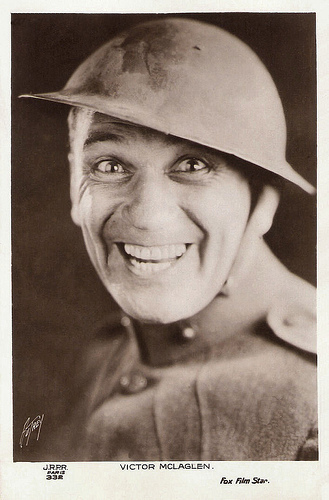
Victor McLaglen . French postcard by J.R.P.R., Paris, no. 332. Photo: Max Munn Autrey / Fox. Publicity still for What Price Glory? (Raoul Walsh, 1926).
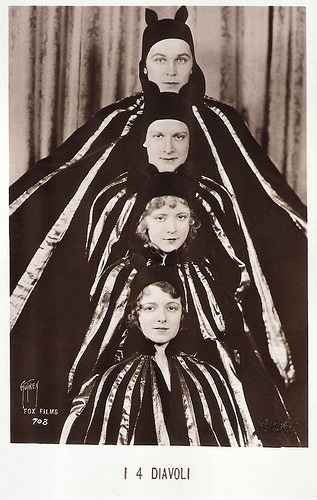
Janet Gaynor , Nancy Drexel, Barry Norton and Charles Morton in 4 Devils (1928). Italian postcard by G.B. Falci Editore, Milano, no. 708. Photo: Max Munn Autrey / Fox. Publicity still for 4 Devils (Friedrich Wilhelm Murnau, 1928).
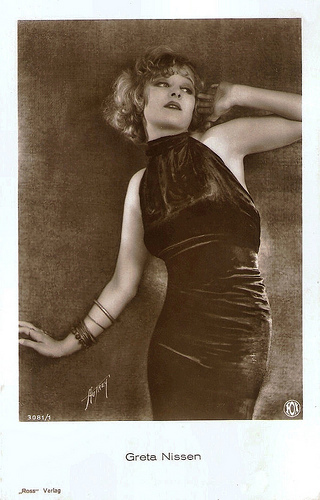
Greta Nissen . German postcard by Ross Verlag, no. 3081/1, 1928-1929. Photo: Max Munn Autrey / Fox.
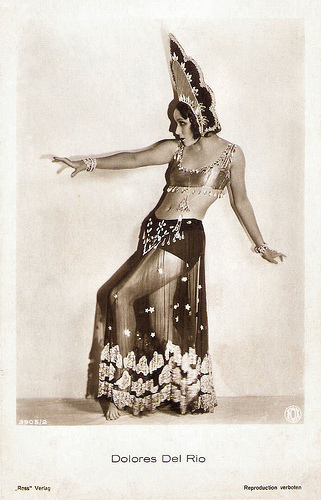
Dolores del Rio in The Red Dance (1928). German postcard by Ross Verlag, no. 3905/2, 1928-1929. Photo: Max Munn Autrey / Fox. Publicity still for The Red Dance (Raoul Walsh, 1928). Del Rio is wearing a kokoshnik (Russian: коко́шник; IPA: [kɐˈkoʂnʲɪk]), a traditional Russian head-dress worn by women and girls.
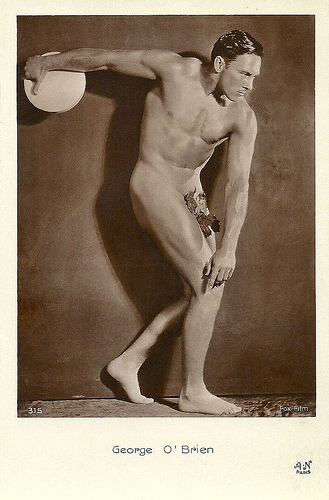
George O'Brien. French postcard by A.N., Paris, no. 315. Photo: Max Munn Autrey / Fox Film. Collection: Didier Hanson.
Mystique and sensuousness
Max Munn Autrey was born in 1891 in Dallas, Texas, USA.
He was trained as a painter, but as an adult, Autrey moved around the state taking photographs. He was employed by P.T. Collier & Son in Dallas, per his World War I registration papers.
In 1918, he married his wife, Bonnie, in her hometown of Tyler. They lived in Burleson in 1920, but soon decided to move to California.
In 1922, the great Hollywood photographer Albert Witzel needed a steady hand to help produce the many portraits turned out by his studio, occasioned by the departure of his head photographer Walter Frederick Seely to establish his own studio.
Autrey’s artistry impressed the portraitist, renowned for producing high-quality, striking images. Autrey found his niche in portraiture, helping devise mystique and sensuousness in star portraits. Clients loved the lush look of his portraits and seated compositions.
Industry enthusiasm for Autrey’s work was so great that Witzel established a branch studio in Hollywood, run by Autrey from 1922 to 1925. Pictures and Picture Goer called Autrey “a master photographer” in an August 1925 article, stating that he produced most of the Witzel Studios portraits and earned that position only two months after joining the studio.
The Fox Film Corporation quickly seized upon Autrey and his talents, signing him to an exclusive contract late in the year. His first assignment as a still photographer for Fox was the drama Hell's Four Hundred (John Griffith Wray, 1926) starring Margaret Livingston.
Soon followed more prestigious assignments like What Price Glory? (Raoul Walsh, 1926), 7th Heaven (Frank Borzage, 1927) with Charles Farrell and Janet Gaynor , and Street Angel (Frank Borzage, 1928). Autrey became noted for his glamorous style.
For director Friedrich Wilhelm Murnau he did the stills for Sunrise (Friedrich Wilhelm Murnau, 1927) starring George O'Brien and Janet Gaynor , and the lost masterpiece Four Devils (1928). Later followed Dressed to Kill (1928) with Mary Astor.
Autrey portrayed many film stars. He photographed Madge Bellamy coyly poised on tiptoe for The Play Girl (Arthur Rosson, 1928) and portrayed Dolores del Rio as an exotic Russian dancer for The Red Dance (Raoul Walsh, 1928).
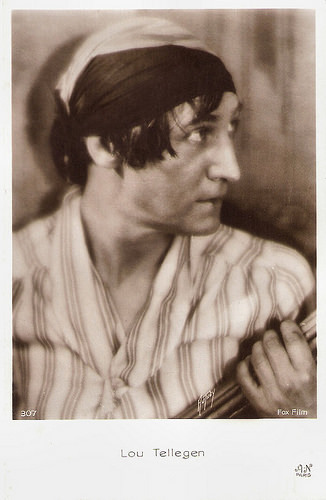
Lou Tellegen . French postcard by A.N., Paris, no. 307. Photo: Max Munn Autrey / Fox Film.
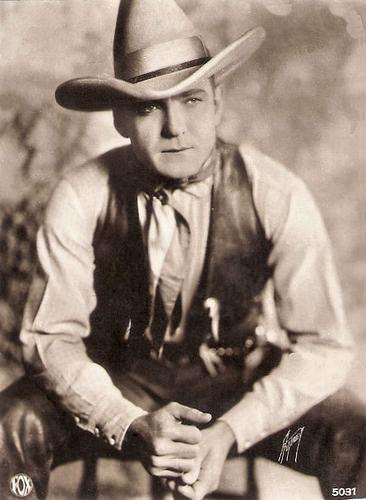
Buck Jones. French postcard, no. 5031. Photo: Max Munn Autrey / Fox.
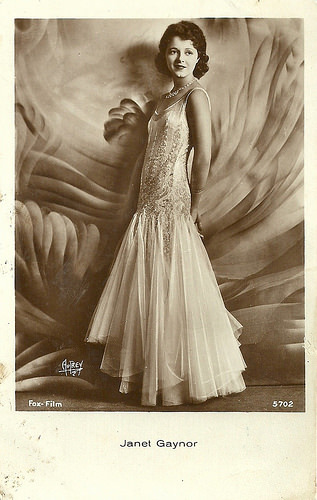
Janet Gaynor . Austrian postcard by Iris-Verlag, no. 5702. Photo Max Munn Autrey / Fox Film.
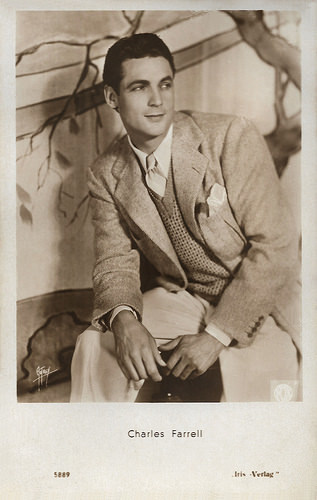
Charles Farrell. Austrian postcard by Iris-Verlag, no. 5889. Photo: Max Munn Autrey / Fox.
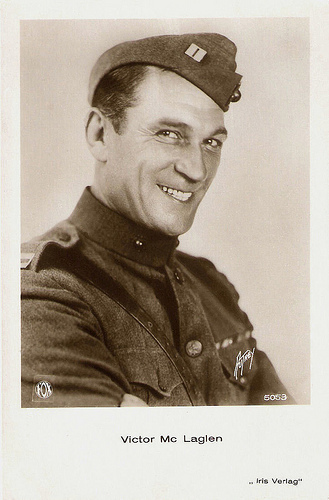
Victor McLaglen in What Price Glory? (1926). Austrian postcard by Iris Verlag, no. 5053. Photo: Max Munn Autrey / Fox. Publicity still for What Price Glory? (Raoul Walsh, 1926).
A sharp focus, high-contrast style
Max Autrey employed a sharp focus, high-contrast style, inscribing his name into the negative. Fox stars soon appeared as radiant and ravishing as those at the more luxurious studios, posing as Jazz Age cuties, holiday belles, and, like actor George O’Brien, almost nude camera studies.
One of the best known stars photographed by Max Autrey for Fox is Clara Bow. He photographed her for her early sound film Call Her Savage (John Francis Dillon, 1932). David Atfield at IMDb : “What a film! Daring to tackle issues few films would even look at today. Stunningly photographed and directed, and with greater style than many early talkies.”
Bow was known as the ‘It’ girl. Cathy Curtis in the L.A. Times : “’It’ of course, really meant ‘sex’, and, even in the demure bathing suit of the time, Bow's exuberant, upraised-arm stance in swirling surf gave her an air of ready-for-anything sauciness.”
In 1932, Autrey established his own portrait studio on the side, where he worked part-time. Many Fox stars and other film people continued coming to him for portraits and special work at the 7075 Sunset Blvd. location.
Autrey’s best known later works are his stills for Chaplin’s Modern Times (Charles Chaplin, 1936). During the same time, his wife, Bonnie, began breeding and selling Irish setters out of their home, dogs which won many awards at competitions.
As time passed, Autrey turned his attention to shooting society portraits, while occasionally making star headshots, which he entered in the Academy of Motion Picture Arts and Sciences Still Show.
During World War II, he shot photographs of soldiers on leave. While Autrey and many of his peers like Fred Hartsook, Albert Witzel, Nelson Evans, and Melbourne Spurr helped devise and establish the field of glamour photography in the 1910s and 1920s, they were all virtually forgotten by the 1950s and 1960s. In 1967, Autrey closed his studio and retired.
Max Munn Autrey died in 1971 in Los Angeles, California at the age of 80, with little notice taken in local newspapers. In 1996, his photos were hanging alongside master photographer George Hurrell’s in the exhibition Still Men: The Glamour Photography of Max Munn Autrey and George Hurrell, 1920-1940 at the Laguna Beach Museum. It was the start of the rediscovery of one of the major pioneers of Hollywood glamour photography.
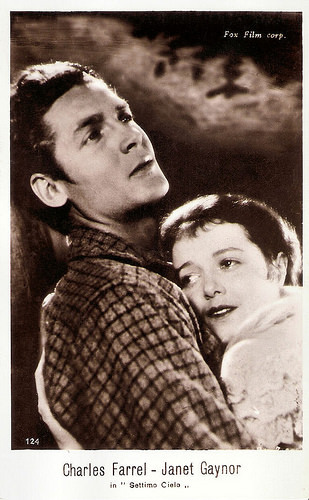
Janet Gaynor and Charles Farrell in Seventh Heaven (1927). Italian postcard offered by Cioccolata Lurati, no. 124. Photo: Max Munn Autrey / Fox. Publicity still for Seventh Heaven (Frank Borzage, 1927).
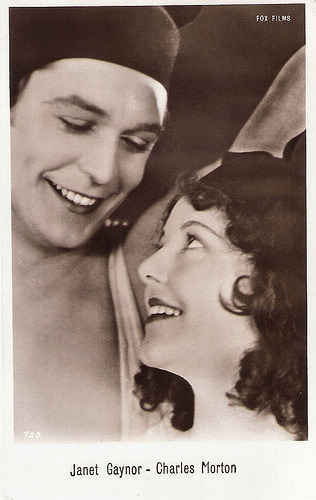
Janet Gaynor and Charles Morton in 4 Devils (1928). Italian postcard by G.B. Falci Editore, Milano, no. 720. Photo: Max Munn Autrey / Fox. Publicity still for 4 Devils (Friedrich Wilhelm Murnau, 1928).
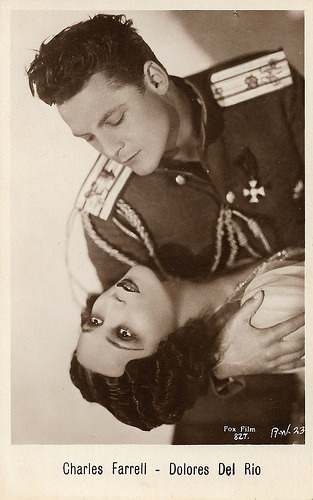
Charles Farrell and Dolores del Rio in The Red Dance (1928). Italian postcard by G.B. Falci, Milano, no. 827. Photo: Max Munn Autrey / Fox Film. Publicity still for The Red Dance (Raoul Walsh, 1928).
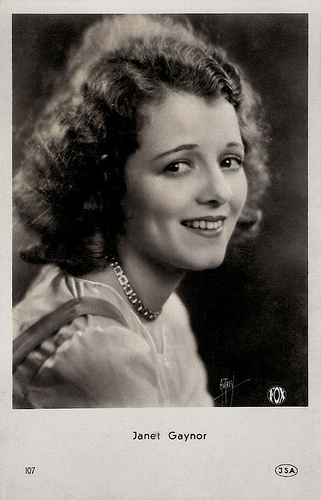
Janet Gaynor. Dutch postcard by J.S.A., no 107. Photo: Max Munn Autrey / Fox.
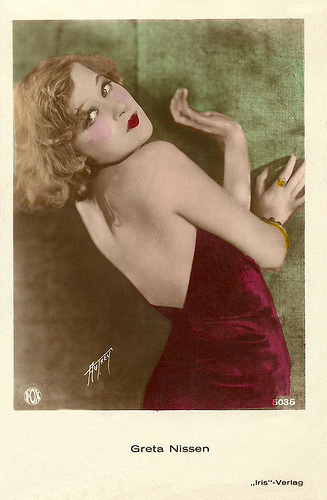
Greta Nissen . Austrian postcard by Iris-Verlag, no. 5035. Photo: Max Munn Autrey / Fox.
Sources: Larry Harnish / Mary Mallory (The Daily Mirror), Cathy Curtis (LA Times), David Atfield (IMSb), Vintage Movie Star Photos, and .

Victor McLaglen . French postcard by J.R.P.R., Paris, no. 332. Photo: Max Munn Autrey / Fox. Publicity still for What Price Glory? (Raoul Walsh, 1926).

Janet Gaynor , Nancy Drexel, Barry Norton and Charles Morton in 4 Devils (1928). Italian postcard by G.B. Falci Editore, Milano, no. 708. Photo: Max Munn Autrey / Fox. Publicity still for 4 Devils (Friedrich Wilhelm Murnau, 1928).

Greta Nissen . German postcard by Ross Verlag, no. 3081/1, 1928-1929. Photo: Max Munn Autrey / Fox.

Dolores del Rio in The Red Dance (1928). German postcard by Ross Verlag, no. 3905/2, 1928-1929. Photo: Max Munn Autrey / Fox. Publicity still for The Red Dance (Raoul Walsh, 1928). Del Rio is wearing a kokoshnik (Russian: коко́шник; IPA: [kɐˈkoʂnʲɪk]), a traditional Russian head-dress worn by women and girls.

George O'Brien. French postcard by A.N., Paris, no. 315. Photo: Max Munn Autrey / Fox Film. Collection: Didier Hanson.
Mystique and sensuousness
Max Munn Autrey was born in 1891 in Dallas, Texas, USA.
He was trained as a painter, but as an adult, Autrey moved around the state taking photographs. He was employed by P.T. Collier & Son in Dallas, per his World War I registration papers.
In 1918, he married his wife, Bonnie, in her hometown of Tyler. They lived in Burleson in 1920, but soon decided to move to California.
In 1922, the great Hollywood photographer Albert Witzel needed a steady hand to help produce the many portraits turned out by his studio, occasioned by the departure of his head photographer Walter Frederick Seely to establish his own studio.
Autrey’s artistry impressed the portraitist, renowned for producing high-quality, striking images. Autrey found his niche in portraiture, helping devise mystique and sensuousness in star portraits. Clients loved the lush look of his portraits and seated compositions.
Industry enthusiasm for Autrey’s work was so great that Witzel established a branch studio in Hollywood, run by Autrey from 1922 to 1925. Pictures and Picture Goer called Autrey “a master photographer” in an August 1925 article, stating that he produced most of the Witzel Studios portraits and earned that position only two months after joining the studio.
The Fox Film Corporation quickly seized upon Autrey and his talents, signing him to an exclusive contract late in the year. His first assignment as a still photographer for Fox was the drama Hell's Four Hundred (John Griffith Wray, 1926) starring Margaret Livingston.
Soon followed more prestigious assignments like What Price Glory? (Raoul Walsh, 1926), 7th Heaven (Frank Borzage, 1927) with Charles Farrell and Janet Gaynor , and Street Angel (Frank Borzage, 1928). Autrey became noted for his glamorous style.
For director Friedrich Wilhelm Murnau he did the stills for Sunrise (Friedrich Wilhelm Murnau, 1927) starring George O'Brien and Janet Gaynor , and the lost masterpiece Four Devils (1928). Later followed Dressed to Kill (1928) with Mary Astor.
Autrey portrayed many film stars. He photographed Madge Bellamy coyly poised on tiptoe for The Play Girl (Arthur Rosson, 1928) and portrayed Dolores del Rio as an exotic Russian dancer for The Red Dance (Raoul Walsh, 1928).

Lou Tellegen . French postcard by A.N., Paris, no. 307. Photo: Max Munn Autrey / Fox Film.

Buck Jones. French postcard, no. 5031. Photo: Max Munn Autrey / Fox.

Janet Gaynor . Austrian postcard by Iris-Verlag, no. 5702. Photo Max Munn Autrey / Fox Film.

Charles Farrell. Austrian postcard by Iris-Verlag, no. 5889. Photo: Max Munn Autrey / Fox.

Victor McLaglen in What Price Glory? (1926). Austrian postcard by Iris Verlag, no. 5053. Photo: Max Munn Autrey / Fox. Publicity still for What Price Glory? (Raoul Walsh, 1926).
A sharp focus, high-contrast style
Max Autrey employed a sharp focus, high-contrast style, inscribing his name into the negative. Fox stars soon appeared as radiant and ravishing as those at the more luxurious studios, posing as Jazz Age cuties, holiday belles, and, like actor George O’Brien, almost nude camera studies.
One of the best known stars photographed by Max Autrey for Fox is Clara Bow. He photographed her for her early sound film Call Her Savage (John Francis Dillon, 1932). David Atfield at IMDb : “What a film! Daring to tackle issues few films would even look at today. Stunningly photographed and directed, and with greater style than many early talkies.”
Bow was known as the ‘It’ girl. Cathy Curtis in the L.A. Times : “’It’ of course, really meant ‘sex’, and, even in the demure bathing suit of the time, Bow's exuberant, upraised-arm stance in swirling surf gave her an air of ready-for-anything sauciness.”
In 1932, Autrey established his own portrait studio on the side, where he worked part-time. Many Fox stars and other film people continued coming to him for portraits and special work at the 7075 Sunset Blvd. location.
Autrey’s best known later works are his stills for Chaplin’s Modern Times (Charles Chaplin, 1936). During the same time, his wife, Bonnie, began breeding and selling Irish setters out of their home, dogs which won many awards at competitions.
As time passed, Autrey turned his attention to shooting society portraits, while occasionally making star headshots, which he entered in the Academy of Motion Picture Arts and Sciences Still Show.
During World War II, he shot photographs of soldiers on leave. While Autrey and many of his peers like Fred Hartsook, Albert Witzel, Nelson Evans, and Melbourne Spurr helped devise and establish the field of glamour photography in the 1910s and 1920s, they were all virtually forgotten by the 1950s and 1960s. In 1967, Autrey closed his studio and retired.
Max Munn Autrey died in 1971 in Los Angeles, California at the age of 80, with little notice taken in local newspapers. In 1996, his photos were hanging alongside master photographer George Hurrell’s in the exhibition Still Men: The Glamour Photography of Max Munn Autrey and George Hurrell, 1920-1940 at the Laguna Beach Museum. It was the start of the rediscovery of one of the major pioneers of Hollywood glamour photography.

Janet Gaynor and Charles Farrell in Seventh Heaven (1927). Italian postcard offered by Cioccolata Lurati, no. 124. Photo: Max Munn Autrey / Fox. Publicity still for Seventh Heaven (Frank Borzage, 1927).

Janet Gaynor and Charles Morton in 4 Devils (1928). Italian postcard by G.B. Falci Editore, Milano, no. 720. Photo: Max Munn Autrey / Fox. Publicity still for 4 Devils (Friedrich Wilhelm Murnau, 1928).

Charles Farrell and Dolores del Rio in The Red Dance (1928). Italian postcard by G.B. Falci, Milano, no. 827. Photo: Max Munn Autrey / Fox Film. Publicity still for The Red Dance (Raoul Walsh, 1928).

Janet Gaynor. Dutch postcard by J.S.A., no 107. Photo: Max Munn Autrey / Fox.

Greta Nissen . Austrian postcard by Iris-Verlag, no. 5035. Photo: Max Munn Autrey / Fox.
Sources: Larry Harnish / Mary Mallory (The Daily Mirror), Cathy Curtis (LA Times), David Atfield (IMSb), Vintage Movie Star Photos, and .
Published on August 10, 2018 22:00
August 9, 2018
Jacques Dutronc
With his nonchalant playboy image and his legendary irony, singer and actor Jacques Dutronc (1943) is one of the most popular performers in the French-speaking world. He wrote successful songs for his later wife Françoise Hardy in the 1960s before moving on to pursue a successful solo career. In 1973, he branched out into film acting, and earned a Cesar for Best Actor in 1992 for the leading role in Van Gogh (1992). Dutronc is often portrayed with a gauloise or a big cigar in the mouth.
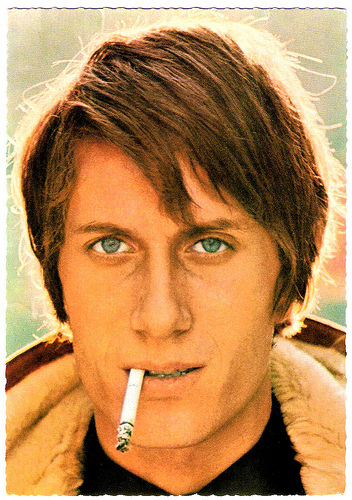
French postcard by Publistar, Marseille, no. 1416. Promotion card for Disques Vogue. Photo: Bernard Leloup (Salut Les Copains).
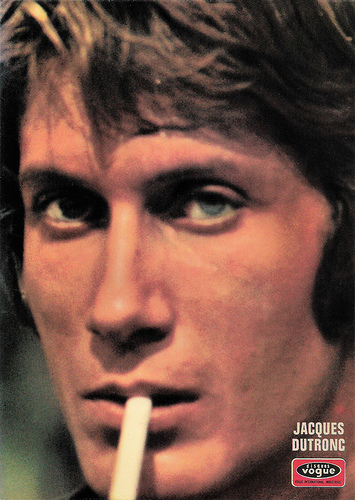
Belgian postcard by Edt Decker, Brussels, no. A 119. Photo: Disques Vogue.
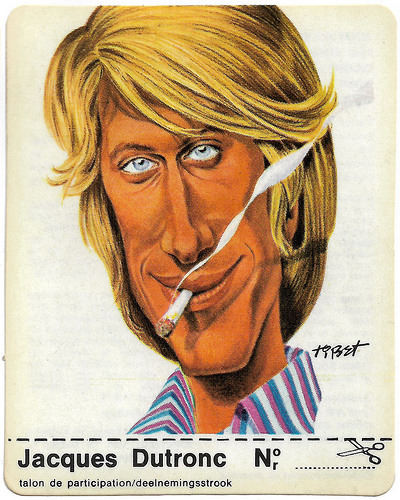
Belgian collectors Card by Clark, Brussels. Illustration: Tibet.
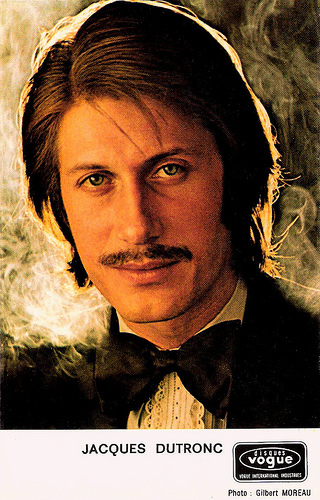
French promotion card for Disques Vogue. Photo: Gilbert Moreau.
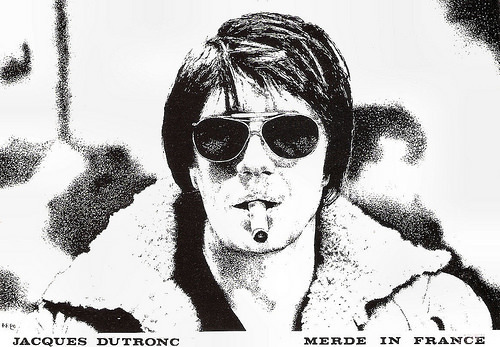
French postcard by Editions F. Nugeron, Tessancourt, no. CP 374. Design: G. Ochecki. Caption: Merde in France.
Openly Provocative Style
Jacques Dutronc was born in Paris in 1943. He grew up in a highly musical environment at home as his father, an engineer, was a passionate music fan.
Jacques learned to play the piano at an early age and soon progressed to the guitar, which would become the favourite instrument of his teenage years. Between 1963 and 1964, Dutronc played guitar for the yé-yé group El Toro et les Cyclones. During this time he also appeared as backing guitarist for 60s star Eddy Mitchell , the former lead singer of Les Chaussettes Noires.
His teenage music career was cut short, when he was sent off to do his miltary service in Germany. After his return, he landed a job as an assistant of Jacques Wolfsohn at Vogue Records. He arranged songs for several lesser known artists such as Zou Zou and Cleo.
Dutronc later wrote a whole string of hits for the popular teenage star Françoise Hardy including Va pas prendre un tambour and C'est le temps de l'amour. He teamed up with writer Jacques Lanzmann, and one of their first commissions was for the pop singer Benjamin.
After Benjamin's first EP failed to perform, Vogue Records dismissed the singer. After hearing one of the demos that Dutronc had produced, his boss declared that Jacques should perform the record for release. This single, Et moi, et moi, et moi (1966) turned Dutronc into a star. (In 1973, an English version Alright Alright Alright became an international hit for the group Mungo Jerry.)
The French public adored the singer’s nonchalant stage persona and his openly provocative style. In an age where most pop stars were growing hippy beards and dressing in Afghan coats and bell-bottom jeans, Dutronc’s tailored suits and chic silk ties were guaranteed to make him stand out from the crowd.
The 10-year collaboration of Lanzmann and Dutronc produced several of Dutronc’s best-known hits. His songs combine American and British musical influences with French lyrical themes. Many of his early songs feature a British garage sound comparable to that of Ray Davies of The Kinks.
Dutronc is distinctive for his mocking attitude toward late 1960s French youth culture. His biggest hit was Il est cinq heures, Paris s'eveille, in which he paints an evocative portrait of the French capital in the early morning hours.
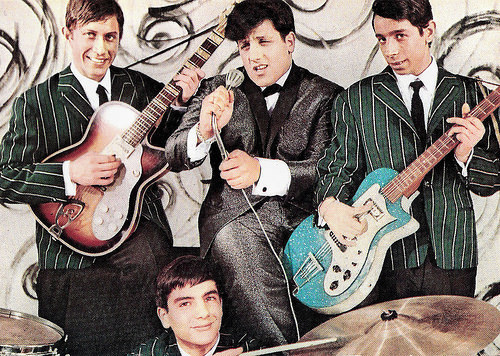
El Toro et les Cyclones. French postcard by Éditions Publistar (E.P.M.B.), no. 759. Photo: Disques Vogue.
El Toro et les Cyclones was a French rock group, active in the early 1960s. Their songs included French versions of foreign hits like L'Oncle John (Long Tall Sally) in 1961 and Le Vagabond (The Wanderer) in 1962. The group members were Daniel Dray (singer), Jacques Dutronc (solo guitar), Hadi Kalafate (bass guitar) and Charles Benarroch (drums). In 1962, Benarroch left the group to form Les Fantômes, and was replaced by André Crudo.
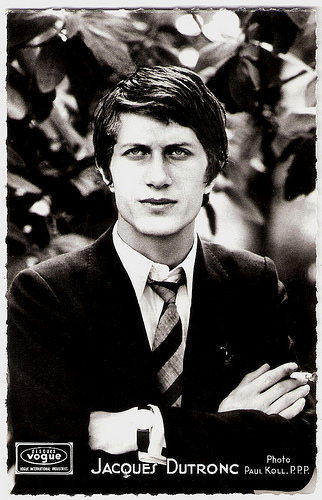
French promotion card by Disques Vogue, no. 1416. Photo: Paul Koll P.P.P.
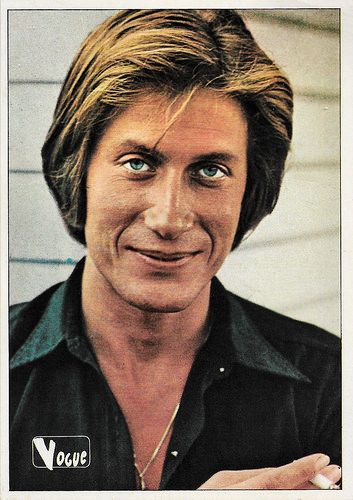
French collectors card in the series 'Hit Collection' by Figurine Panini, no. 37. Photo: Vogue.
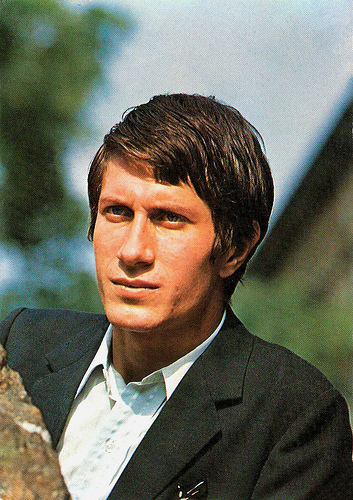
French postcard by PSG, no. 1345. Promotion card for Disques Vogue.
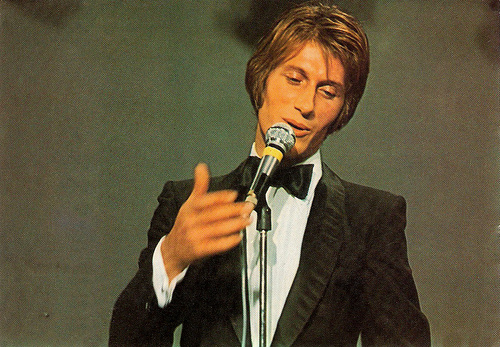
French postcard, no. 3.
Hip Retro Clubs
In 1973, Jacques Dutronc began a second career as a film actor. He made his debut in Antoine et Sébastien/ Antoine and Sebastian (Jean-Marie Périer, 1973) with François Périer .
Next he played Romy Schneider ’s husband in L'important c'est d'aimer/That Most Important Thing: Love (Andrzej Żuławski, 1974). The film was an international hit. He also appeared with her in Mado (Claude Sautet, 1976).
Another popular film was Violette & François (Jacques Rouffio, 1977) in which he co-starred with Isabelle Adjani .
In the 1980s, Dutronc focused on his acting career, and worked sometimes with major directors as Claude Lelouch at A Nous Deux/ An Adventure for Two (1979), Jean-Luc Godard at Sauve qui peut (la vie)/Slow Motion (1980), and Barbet Schroeder at Tricheurs/Cheaters (1984).
Most of his films in this period were mediocre though. Then he was awarded the Cesar for his unusual portrayal of Vincent van Gogh in the final 67 days of his life in Van Gogh (Maurice Pialat, 1992).
He co-starred with Isabelle Huppert in the suspense thriller Merci pour le chocolat/Thanks for the Chocolate (Claude Chabrol, 2000), with Sandrine Bonnaire in C'est la vie/Thats Life (Jean-Pierre Améris, 2001), and with Charlotte Rampling in the comedy Embrassez qui vous voudrez/Summer Things (Michel Blanc, 2002).
Since then he was seen in the thriller Joseph et la fille'/Joseph and the Girl (Xavier De Choudens, 2010), and most recently in the comedy Les Francis (Fabrice Begotti, 2014).
In 2005, he won an honorary César for his whole film career. Jacques Dutronc currently lives in the town of Monticello on the island of Corsica. In 1967 he started to live together with singer Francoise Hardy . They married in 1981 and have a son, Thomas (1973), who grew up to become a successful jazz and pop musician.
Dutronc recorded in 1995 the new album called A part ça. He also enjoyed a resurgence of popular interest in his music. Since the early Dutronc songs had a classic late-sixties freakbeat backing, his songs were played in the hip retro clubs of the UK and US.
In 2010 Dutronc went on a successful new tour with more than 80 concerts. In November 2014, Dutronc performed a series of concerts with Eddy Mitchell and Johnny Hallyday at Paris Bercy, under the name 'Les vieilles canailles (The Old Gits).
In 1998, Jacques Dutromc began a relationship with a stylist whom he had met on the set of the film Place Vendôme. Dutronc and Hardy are now separated, but remain married and see each other regularly. He currently lives in the town of Monticello, Corsica.
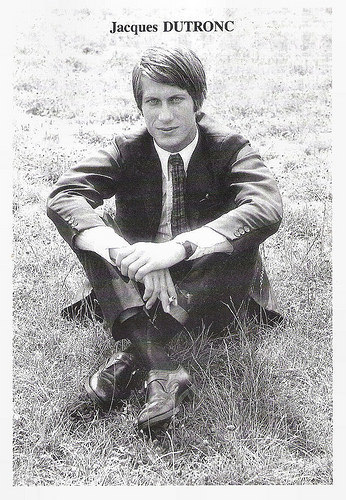
French postcard by Editions Bertrand, Paris, in the series Les Années 60. Photo: Patrick Bertrand.
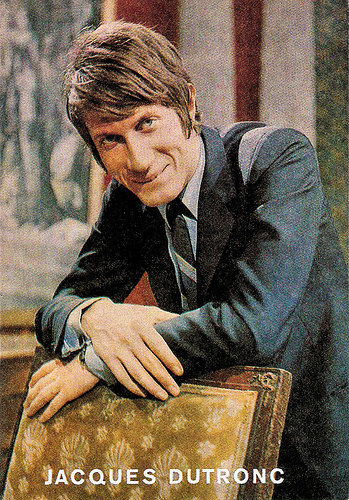
German promotion card by Deutsche Schallplatten Gmbh. Photo: Wolfgang Kühn, Duisburg.
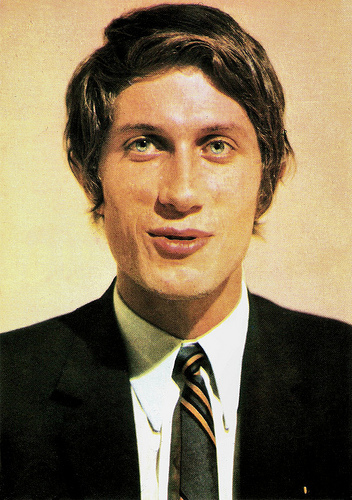
Belgian postcard by Edt Decker, Brussels, no. A 119.
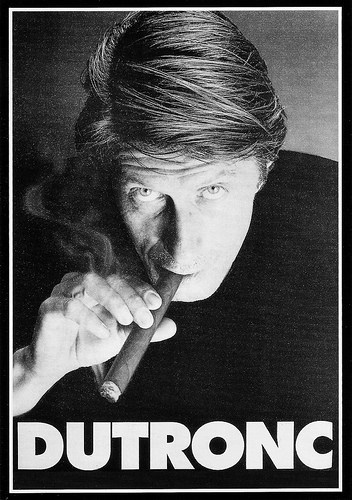
French postcard, no. 202.
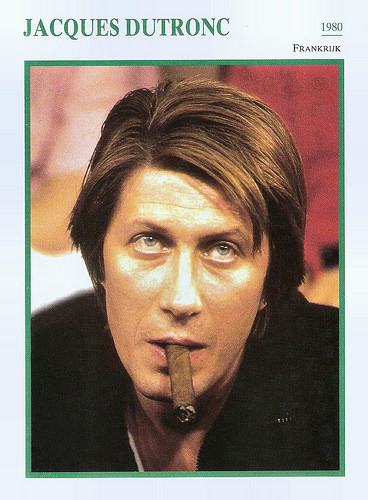
Dutch collectors card in the series 'Filmsterren: een Portret' by Edito Service, 1993. Photo: Collection Christophe L. Caption: Jacques Dutronc, 1980, Frankrijk.
Sources: (IMDb), Wikipedia (English and French) and .

French postcard by Publistar, Marseille, no. 1416. Promotion card for Disques Vogue. Photo: Bernard Leloup (Salut Les Copains).

Belgian postcard by Edt Decker, Brussels, no. A 119. Photo: Disques Vogue.

Belgian collectors Card by Clark, Brussels. Illustration: Tibet.

French promotion card for Disques Vogue. Photo: Gilbert Moreau.

French postcard by Editions F. Nugeron, Tessancourt, no. CP 374. Design: G. Ochecki. Caption: Merde in France.
Openly Provocative Style
Jacques Dutronc was born in Paris in 1943. He grew up in a highly musical environment at home as his father, an engineer, was a passionate music fan.
Jacques learned to play the piano at an early age and soon progressed to the guitar, which would become the favourite instrument of his teenage years. Between 1963 and 1964, Dutronc played guitar for the yé-yé group El Toro et les Cyclones. During this time he also appeared as backing guitarist for 60s star Eddy Mitchell , the former lead singer of Les Chaussettes Noires.
His teenage music career was cut short, when he was sent off to do his miltary service in Germany. After his return, he landed a job as an assistant of Jacques Wolfsohn at Vogue Records. He arranged songs for several lesser known artists such as Zou Zou and Cleo.
Dutronc later wrote a whole string of hits for the popular teenage star Françoise Hardy including Va pas prendre un tambour and C'est le temps de l'amour. He teamed up with writer Jacques Lanzmann, and one of their first commissions was for the pop singer Benjamin.
After Benjamin's first EP failed to perform, Vogue Records dismissed the singer. After hearing one of the demos that Dutronc had produced, his boss declared that Jacques should perform the record for release. This single, Et moi, et moi, et moi (1966) turned Dutronc into a star. (In 1973, an English version Alright Alright Alright became an international hit for the group Mungo Jerry.)
The French public adored the singer’s nonchalant stage persona and his openly provocative style. In an age where most pop stars were growing hippy beards and dressing in Afghan coats and bell-bottom jeans, Dutronc’s tailored suits and chic silk ties were guaranteed to make him stand out from the crowd.
The 10-year collaboration of Lanzmann and Dutronc produced several of Dutronc’s best-known hits. His songs combine American and British musical influences with French lyrical themes. Many of his early songs feature a British garage sound comparable to that of Ray Davies of The Kinks.
Dutronc is distinctive for his mocking attitude toward late 1960s French youth culture. His biggest hit was Il est cinq heures, Paris s'eveille, in which he paints an evocative portrait of the French capital in the early morning hours.

El Toro et les Cyclones. French postcard by Éditions Publistar (E.P.M.B.), no. 759. Photo: Disques Vogue.
El Toro et les Cyclones was a French rock group, active in the early 1960s. Their songs included French versions of foreign hits like L'Oncle John (Long Tall Sally) in 1961 and Le Vagabond (The Wanderer) in 1962. The group members were Daniel Dray (singer), Jacques Dutronc (solo guitar), Hadi Kalafate (bass guitar) and Charles Benarroch (drums). In 1962, Benarroch left the group to form Les Fantômes, and was replaced by André Crudo.

French promotion card by Disques Vogue, no. 1416. Photo: Paul Koll P.P.P.

French collectors card in the series 'Hit Collection' by Figurine Panini, no. 37. Photo: Vogue.

French postcard by PSG, no. 1345. Promotion card for Disques Vogue.

French postcard, no. 3.
Hip Retro Clubs
In 1973, Jacques Dutronc began a second career as a film actor. He made his debut in Antoine et Sébastien/ Antoine and Sebastian (Jean-Marie Périer, 1973) with François Périer .
Next he played Romy Schneider ’s husband in L'important c'est d'aimer/That Most Important Thing: Love (Andrzej Żuławski, 1974). The film was an international hit. He also appeared with her in Mado (Claude Sautet, 1976).
Another popular film was Violette & François (Jacques Rouffio, 1977) in which he co-starred with Isabelle Adjani .
In the 1980s, Dutronc focused on his acting career, and worked sometimes with major directors as Claude Lelouch at A Nous Deux/ An Adventure for Two (1979), Jean-Luc Godard at Sauve qui peut (la vie)/Slow Motion (1980), and Barbet Schroeder at Tricheurs/Cheaters (1984).
Most of his films in this period were mediocre though. Then he was awarded the Cesar for his unusual portrayal of Vincent van Gogh in the final 67 days of his life in Van Gogh (Maurice Pialat, 1992).
He co-starred with Isabelle Huppert in the suspense thriller Merci pour le chocolat/Thanks for the Chocolate (Claude Chabrol, 2000), with Sandrine Bonnaire in C'est la vie/Thats Life (Jean-Pierre Améris, 2001), and with Charlotte Rampling in the comedy Embrassez qui vous voudrez/Summer Things (Michel Blanc, 2002).
Since then he was seen in the thriller Joseph et la fille'/Joseph and the Girl (Xavier De Choudens, 2010), and most recently in the comedy Les Francis (Fabrice Begotti, 2014).
In 2005, he won an honorary César for his whole film career. Jacques Dutronc currently lives in the town of Monticello on the island of Corsica. In 1967 he started to live together with singer Francoise Hardy . They married in 1981 and have a son, Thomas (1973), who grew up to become a successful jazz and pop musician.
Dutronc recorded in 1995 the new album called A part ça. He also enjoyed a resurgence of popular interest in his music. Since the early Dutronc songs had a classic late-sixties freakbeat backing, his songs were played in the hip retro clubs of the UK and US.
In 2010 Dutronc went on a successful new tour with more than 80 concerts. In November 2014, Dutronc performed a series of concerts with Eddy Mitchell and Johnny Hallyday at Paris Bercy, under the name 'Les vieilles canailles (The Old Gits).
In 1998, Jacques Dutromc began a relationship with a stylist whom he had met on the set of the film Place Vendôme. Dutronc and Hardy are now separated, but remain married and see each other regularly. He currently lives in the town of Monticello, Corsica.

French postcard by Editions Bertrand, Paris, in the series Les Années 60. Photo: Patrick Bertrand.

German promotion card by Deutsche Schallplatten Gmbh. Photo: Wolfgang Kühn, Duisburg.

Belgian postcard by Edt Decker, Brussels, no. A 119.

French postcard, no. 202.

Dutch collectors card in the series 'Filmsterren: een Portret' by Edito Service, 1993. Photo: Collection Christophe L. Caption: Jacques Dutronc, 1980, Frankrijk.
Sources: (IMDb), Wikipedia (English and French) and .
Published on August 09, 2018 22:00
Paul van Yperen's Blog
- Paul van Yperen's profile
- 13 followers
Paul van Yperen isn't a Goodreads Author
(yet),
but they
do have a blog,
so here are some recent posts imported from
their feed.



